- Things to Do
- Food & Drink
- Shopping & Style
- Coca-Cola Foodmarks
- Restaurants & Cafes
- Music & Nightlife
- Neighborhoods
- Los Angeles


5 best travel shows about Japan
Explore Japanese food, culture and landscapes with Elliot Page, Joanna Lumley, James May and more

Okay, so international travel isn’t completely feasible yet, but you can still look for some inspiration to start planning your next big trip. Whether you’re tagging along with Elliot Page to explore the ins and outs of Shinjuku Nichome , or getting to know the delights of the Japanese onsen with Top Gear’s James May, these whimsical travel shows are bound to fuel your wanderlust.
Covering Japan from the eccentricities of modern Tokyo to the most traditional elements of Japanese culture, here are the best travel shows to take you on a whirlwind adventure without leaving home.
RECOMMENDED: The best documentaries about Japanese food
Travel at home
Joanna lumley's japan.

In this series, beloved British actress Joanna Lumley (Absolutely Fabulous) starts her journey in the sub-zero temperatures of Hokkaido before making her way to Honshu, Japan’s cultural heartland. Taking boats, planes and speedy bullet trains to make her 2,000-mile journey, Lumley is a delightfully charming travel companion, always ready with a witty quip.
From the spectacular views of natural world heritage sites to jetting over some of Japan’s most active volcanoes, the series is an excitement-packed feast for the eyes. After taking part in a karate class and swinging fire for a festival in Akita, Lumley concludes her trip in Tokyo by attending a riotous ‘girl band’ concert where the average age is 84.
Available on Netflix in some regions outside of Japan.
Prime Japan

Discover the joys of staying in a traditional ryokan and ponder the nation’s obsession with cats in this extensive series about Japan on Amazon Prime . If an itinerary of lugging heavy bags through crowded streets and tourist hotspots sounds like a far cry from a holiday to you, be soothed by these scenes of calming natural landscapes and private sushi counters.
Rather than a surface-level introduction to iconic dishes like sushi and ramen, viewers are shown the history and origins of each food as well as the meticulous process of sourcing ingredients to make them. An exploration of old and new, this series takes you from the traditional Buddhist practice of Zen meditation to the cutting-edge designs that put Japan on the map for modern technology.
James May: Our Man in Japan

Follow Top Gear’s former host James May as he journeys across Japan from the busy streets of Tokyo to the shrines and temples of Kyoto. Far from the average travel show with dry narration and slow filler shots of landscapes, May’s antics make this cultural exploration as funny as it is informative.
Curious to learn about what goes down at the annual Kanamara Matsuri Penis Festival? What all the fuss for pachinko parlours is about? May sets out to investigate all that and more in six wildly entertaining episodes. Sure, there are genuinely beautiful scenes featuring venues like Odaiba’s teamLab Borderless Museum and a traditional tea ceremony hosted by a real geisha, but it’s the comical social faux pas and mishaps that make the show one of the best of its kind.

Gaycation: Japan
In this series , actor Elliot Page (Umbrella Academy) and his friend Ian Daniel explore different corners around the world to better understand how LGBTQ+ communities vary across cultures. Though the series doesn't shy away from dealing with the marginalisation of LGBTQ+ people, Page and Daniel also cover significant ground touring the most distinctive parts of each city they visit. In the Japan episode, Page begins by exploring a traditional shrine before heading to Shinjuku Nichome’s smallest lesbian bar.
Queer Eye: We're in Japan!

Queer Eye’s mini-series set in Japan is high on our list of the best shows on Netflix for its feel-good factor and style inspo, but the episodes also introduce viewers to a more local side of Tokyo through Japanese cooking sessions and ikebana workshops. Along the way, TV icons Kiko Mizuhara and Naomi Watanabe join in to teach the Fab Five a thing or two about Japanese customs and traditions.

Best Japanese movies and series with English subtitles on Netflix
Locally produced, binge-worthy titles to add to your watch list

The best Japanese horror films
Forget the Hollywood remakes – Japan produces some of the best and most original horror movies around

10 best Studio Ghibli films
We’ve compiled this list of the studio’s best anime films. Spoiler: it’s not all about Miyazaki
[image] [title]
Discover Time Out original video
By entering your email address you agree to our Terms of Use and Privacy Policy and consent to receive emails from Time Out about news, events, offers and partner promotions.
🙌 Awesome, you're subscribed!
Thanks for subscribing! Look out for your first newsletter in your inbox soon!
- Terms of use
- Work for Time Out
- Time Out Group
- Advertising
- Modern slavery statement
- Manage cookies
Time Out Tokyo
- Magazine subscription
- Digital edition
- Buy the guide to Tokyo
Time Out products
- Time Out Worldwide
- Skip to main content
- Skip to primary sidebar

Destinations
- Plan Your Trip
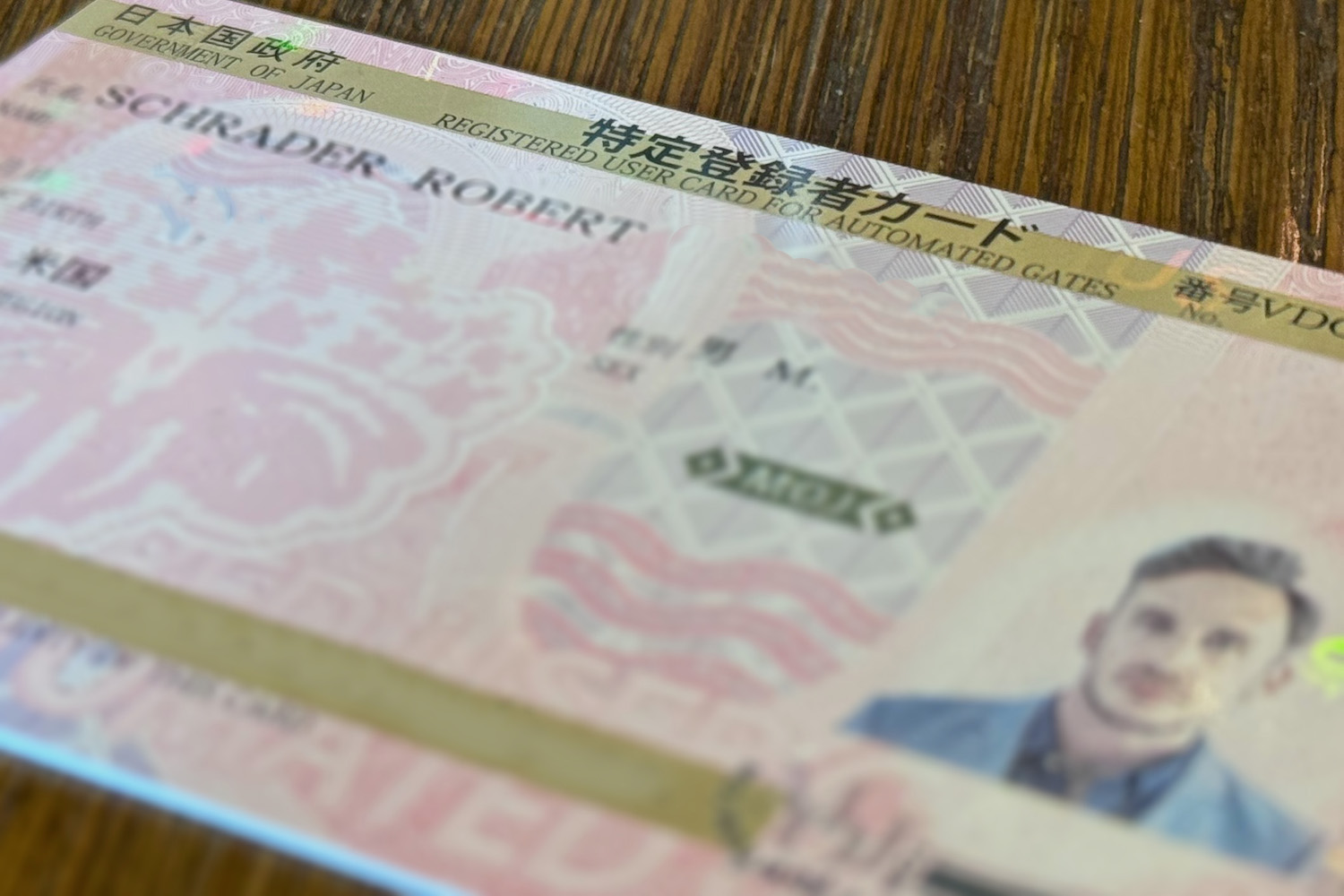
Japan’s Answer to Global Entry
November 9, 2023 by Robert Schrader Leave a Comment
As tourism Japan surged prior to (and since) the coronavirus pandemic, it’s become an increasingly common experience to wait an hour or longer to clear immigration at the country’s main airports. This can be annoying if you’re staying in Tokyo or the Kansai region, but downright disruptive if you’re bound for points farther afield.
The bad news? Japan so far remains resistant to the kiosks that now allowed expedited entry (for holders of certain passports) that have popped up in countries from Australia to Singapore.
The good news? If you can jump through the hoops of enrolling in the Japan Trusted Traveler program, entering Japan will become a great deal less painful.
What is the Japan Trusted Traveler Program?
Launched quietly in 2016, the Japan Trusted Traveler program allows foreign travelers to use the automated entry gates that Japanese citizens and residents have always (well, at least since said gates were introduced) been able to use. It sets out a number of categories that, if a foreign travelers falls into one or more, can qualify him or her for the program, which also requires the payment of a small fee.
From the perspective of American travelers, the TTP (to which it’s sometimes abbreviated) can seem like Global Entry, even if the technology is a bit more static. For example, while Global Entry kiosks in the early 2020s allow qualified travelers to enter the US solely using biometric imaging—in theory, a passport isn’t even necessary—Japan’s Trusted Traveler gates are so far a bit less sophisticated.
Steps for Becoming a Japan Trusted Traveler
Fill out the application.
The step to joining Japan’s Trusted Travel Program, unsurprisingly, is applying online here . As the application form specifies, you need to “quality” under certain criteria, with the most common being that you are a member of Global Entry, or that you had a “Platinum” credit card, such American Express Platinum. You also need to be a frequent Japan traveler, with at least two trips taken in the past six months.
Pass preliminary inspection
Once you’ve completed your application for the Japan Trusted Traveler program—make sure to double- and triple-check your application, as any errors will result in automatic rejection—wait to be approved. Depending on processing loads, this can take as little as a couple weeks and as long as a couple months.
Come to Japan
You’ll need to come to Japan within six months of the date that you pass primary inspection in order to complete the process. Note that you’ll need to present documentation at this time (your Global Entry card; your Platinum credit card) and also, payment for the fee (¥2,220 as of November 2023), but not in cash—more on that in a second.
Go through secondary inspection
Once in Japan, the final step of the Japan Trusted Traveler program application is passing the secondary inspection, which can be conducted either at arrival immigration at major airports like Haneda, Narita and Kansai, or at the immigration office near check-in area A of Haneda’s departure lobby.
Read the fine print
As mentioned above, the Japan TTP fee payment isn’t able to be done in cash—you have to pay with revenue stamps. You can only purchase these once you’re in Japan (at any post office), so if you want to do the secondary inspection upon entry, buy these the next time you’re in Japan, even if it’s before you start applying.
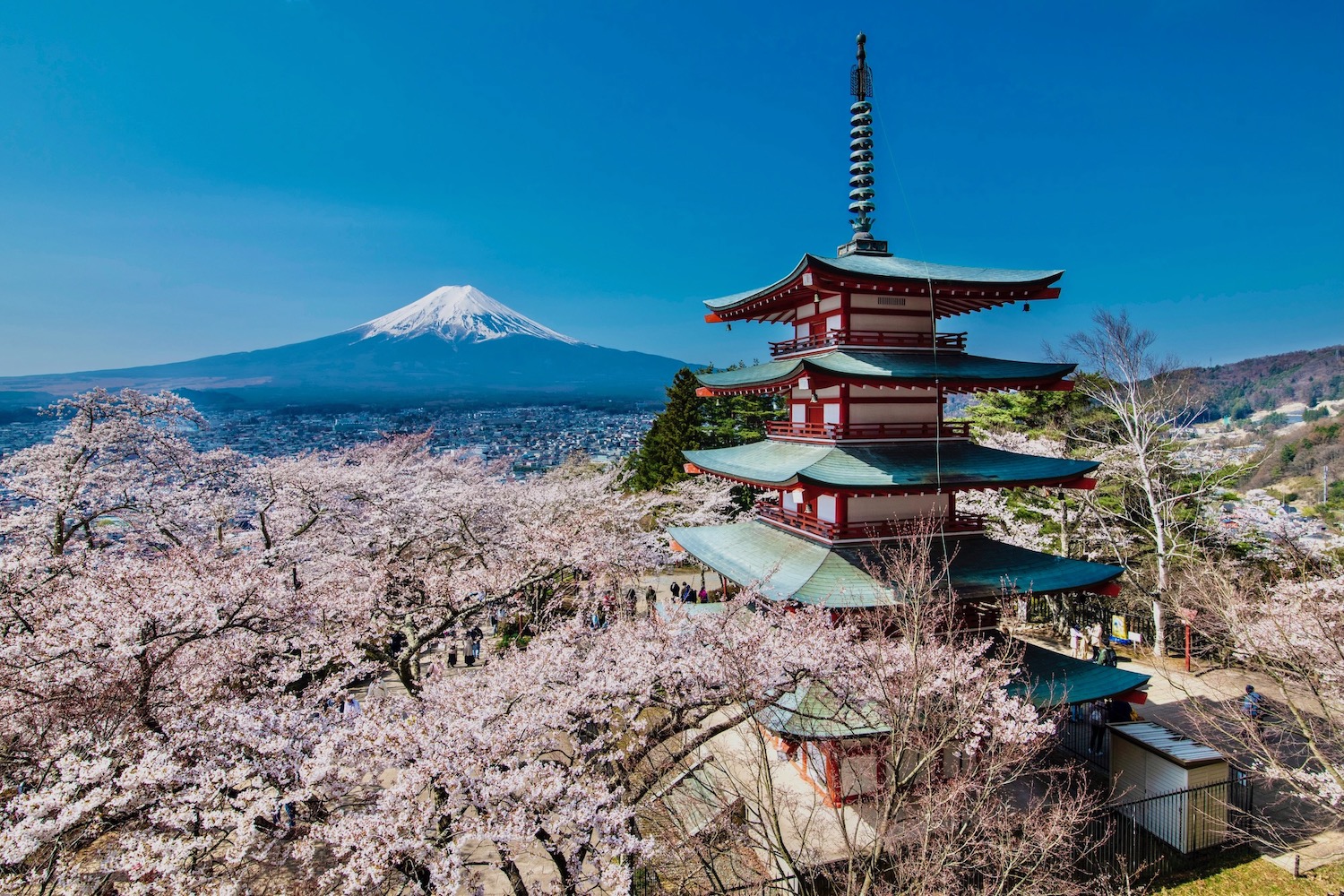
Japan TTP vs. APEC Business Travel Card
If you’re a frequent traveler in the Asia-Pacific region (particularly if you travel for business), you may already have the APEC Business Travel Card, sometimes abbreviated to ABTC. This allows you expedited access to the immigration queue in Japan, and while it’s not a kiosk, offers the same speed of entry into the country as membership in TTP does. There’s another difference, however, which could make TTP enrollment worthwhile.
The Japan Trusted Traveler card is legal ID in Japan, which means that having one exempts you from the requirement to carry your passport with you at all times. (You say you didn’t know this was mandatory? Well, now you do.) While this might seem like a small benefit, for me it offers a lot of peace of mind. For example, I obviously never carried my passport while exercising (and thus chanced being “caught”); now I no longer need to worry.
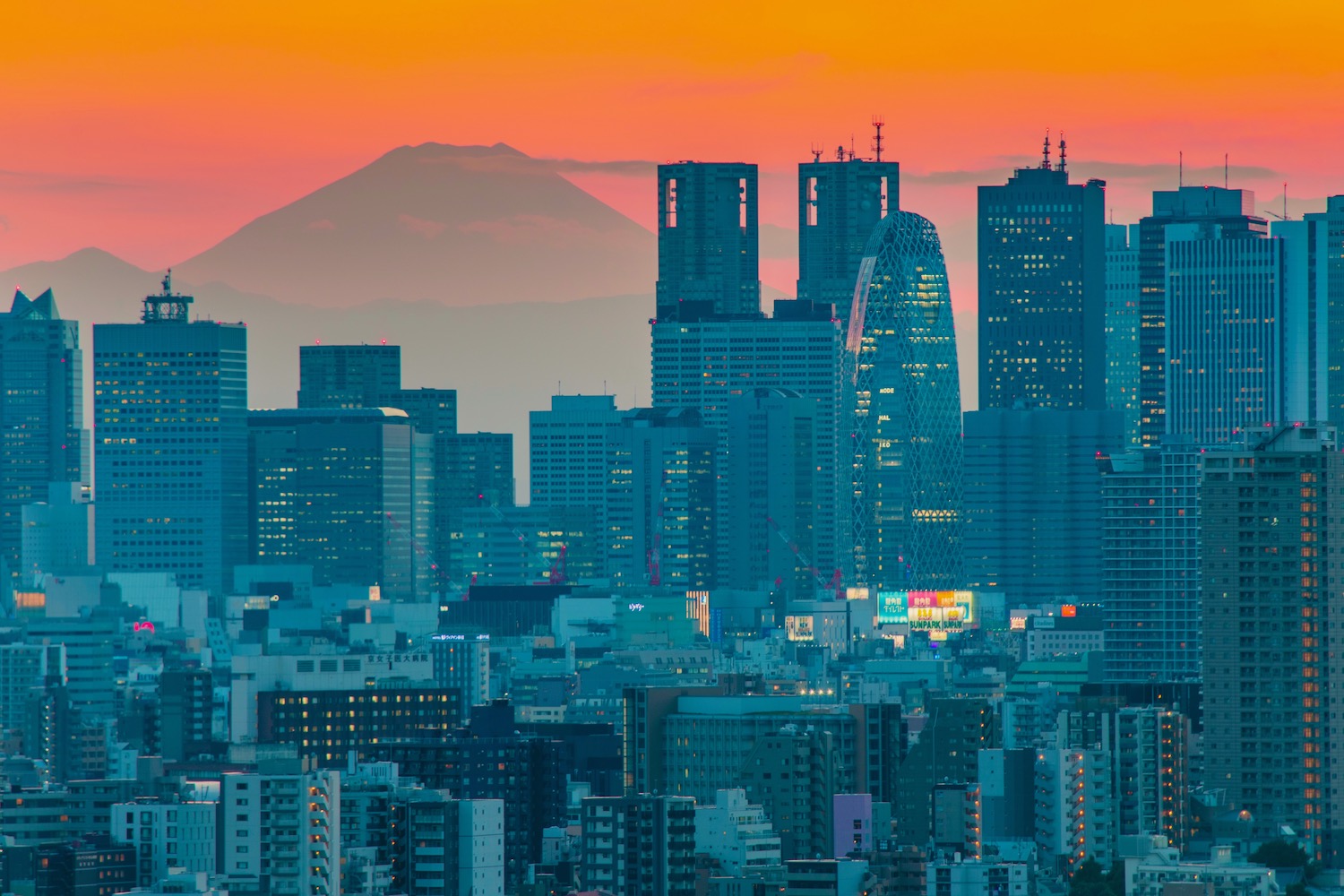
Other FAQ About the Japan Trusted Traveler Program
Is japan part of global entry.
Japan is part of Global Entry in the sense that Japanese travelers who meet certain criteria can use Global Entry kiosks when entering the US. Since 2016, American travelers enrolled in Global Entry have been able to register for Japan’s Trusted Traveler program (which is similar to Global Entry, but not quite as convenient) on a reciprocal basis.
How do I expedite entry to Japan?
For nonresident foreigners, there are two basic ways to expedite entry into Japan, as of November 2023. The first is to enroll in the Japan Trusted Traveler program, which is essentially Japan’s answer to Global Entry in the US. The second is to obtain an APEC Business Traveler Card, which is available to frequent business travelers in the Asia-Pacific region.
What is the revenue stamp for Japan Trusted Traveler Program?
One of the most tedious aspects of enrolling in Japan’s Trusted Traveler Program is the requirement to pay the fee (¥2,220 as of November 2023) in revenue stamps. Known in Japanese as shūnyū inshi (収入印紙), these stamps can be purchased in cash at any Japan Post outlet, where at least one member of staff should be able to speak English.
The Bottom Line
It might be an exaggeration to say that the Japan Trusted Traveler program will change your life, but it will make it a lot easier, at least until Japan allows for universal automated entry. Indeed, I encourage you not to let the cumbersome enrollment process dissuade you from joining. The benefits of having a Trusted Traveler card far outweigh any annoyance you’ll encounter signing up for it, which if I’m honest is more tedious than it is difficult. Want to make sure your next trip to Japan is perfect—I mean, after you’ve quickly cleared immigration at Haneda or Narita ? Then I hope you’ll consider commissioning a custom Japan itinerary!
Plan Your Japan Trip

Subscribe to email updates!
Words, images and design ©2018-2024 Robert Schrader, All rights reserved. Read Privacy Policy or view sitemap .
We’re sorry, this site is currently experiencing technical difficulties. Please try again in a few moments. Exception: request blocked
- Japan Navigator
Journeys in Japan
Explore a different side of Japan. Meet the locals and discover traditions and cultures not usually found in guidebooks!
- About Japan
Visiting Japan
- Information Related to COVID-19 - JapanGov
- Border enforcement measures to prevent the spread of novel coronavirus (COVID-19) - Ministry of Foreign Affairs of Japan
- TeCOT (COVID-19 Testing Center for Overseas Travelers) - Ministry of Economy, Trade and Industry
- Vaccination Certificate for Overseas Travel - Ministry of Health, Labour and Welfare
- Novel Coronavirus (COVID-19) - Ministry of Health, Labour and Welfare
- Coronavirus (COVID-19) advisory information - Japan National Tourism Organization
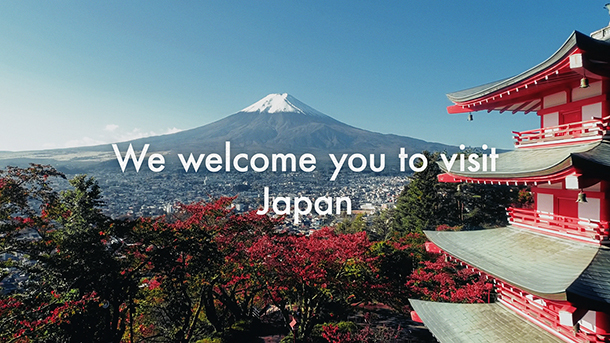
We welcome you to visit Japan
Empowering the Disabled
This movie introduces the new essential steps ahead of an unforgettable travel in Japan.
General Information
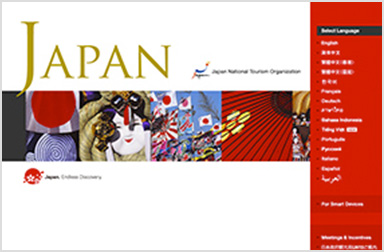
Japan: the Official Guide
Japan National Tourism Organization
General tourism information of Japan in multi languages. Climate, Healthcare, Money, Visa, Emergency info, etc. WEB: http://www.jnto.go.jp/

Open for Professionals
Japan External Trade Organization
The Government of Japan strongly welcomes highly-skilled foreign professionals. WEB: https://www.jetro.go.jp/en/hrportal/
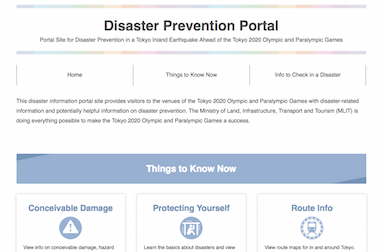
Disaster Prevention Portal
Ministry of Land, Infrastructure, Transport and Tourism
Portal Site for Disaster Prevention in a Tokyo Inland Earthquake Ahead of the Tokyo 2020 Olympic and Paralympic Games. WEB: http://www.mlit.go.jp/en/
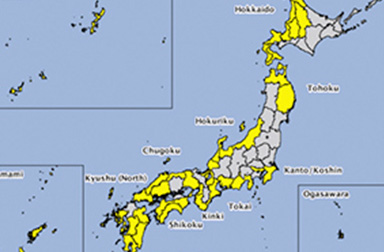
Safety Tips
Safety tips is an app to push notify the disaster information of Japan. Download the app from the website as follow; WEB: http://www.jnto.go.jp/safety-tips/
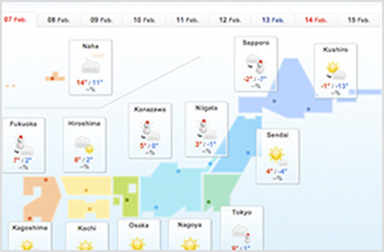
Japan Weather Forecast for Travelers
Weather forecast in English for travelers. WEB: http://www.jnto.go.jp/weather/eng/index.php
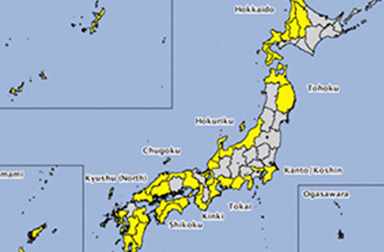
Japan Meteorological Agency
WEB: http://www.jma.go.jp/jma/indexe.html
Embassies, Visas, Customs and other Tourism Related Information
- Japanese Embassies, Consulates and Permanent Missions Overseas [Ministry of Foreign Affairs]
- Visas – Guide to Japanese Visas – [Ministry of Foreign Affairs]
- Customs – Procedures of Passenger Clearance – [Japan Customs]
- The Working Holiday Programmes in Japan [Ministry of Foreign Affairs]
- Animal Quarantine [Ministry of Agriculture, Forestry and Fisheries]
- Plant Protection Station [Ministry of Agriculture, Forestry and Fisheries]
Studying and Teaching
- Study in Japan Comprehensive Guide [Ministry of Foreign Affairs]
- Gateway to study in Japan [Japan Student Services Organization]
- Erin's Challenge! I can speak Japanese [The Japan Foundation]
- Marugoto: Japanese Language and Culture [The Japan Foundation]
- Portal Site on Policies for Foreign Residents [Cabinet Office]
- The Japan Exchange and Teaching Programme (JET)
For a limited time, book your 2020, 2021 & 2022 group tour packages with no deposit required!!!

- Custom Groups Custom Groups Overview Student Groups MICE Special Interest Groups
- About Japan About Japan Destinations Attractions Must See & Do
- About Us About Us Contact us Testimonials Terms & Conditions Travel Agent Services Disclaimer Site Map
- News Press Releases Blog Media
- Your Trip Get Started How to make a reservation Travel Tip FAQs Inquiries
Last Name *
Search Japan Tour by Type
Search group tours, search private journeys, japan tours & vacations | best japanese travel plans and excursions.
All Japan Tours offers unlimited vacation possibilities to explore and experience an unforgettable trip to Japan. Whether you’re interested in Japanese cherry blossom tours , festival tours , autumn leaves tours or special interest tours , our Japan tour packages will bring your vacation dreams to reality. Choose tours based on style , interest , date , or season . Our Japan group tour packages are fully escorted, and we can also arrange special-interest private tours , custom group tours , and other Asia country tours to match your specific needs. | Why All Japan Tours
From Group Tours, to Custom Private Tours, to Japan Luxury Travel
Whether you're planning for a special occasion, family reunion, company event, luxury trip or an entire Japan holiday package, All Japan Tours can help you plan the perfect Japan experience. No matter what your interests are, you are always in excellent hands when you travel with All Japan Tours. Our Japan vacation packages cover all budgets from luxury to adventure and are available with or without international flights for full flexibility. Join an escorted group tour on a pre-designed itinerary, or let us create one for you. We have the firsthand know-how to take you well beyond ordinary travel.
The Best Japan Vacation Packages & Itineraries
When you consider the cost, hassle, and uncertainty of traveling on your own, you'll discover how an All Japan Tours vacation is like no other. Everything has been arranged in advance, from itinerary to hotel accommodations, so all you have to do is take in the breathtaking scenery. There is no need to worry about getting lost or finding transportation; leave the details to us and start having the time of your life. Our team works together to give you the very best Japan vacation. This includes our long-time tour guides in Japan that offer both current and historical enlightenment of its cities and towns, as well as expertise on where to find the most beautiful Japanese gardens and temples, local restaurants, and interesting shops. We understand how important it is to make your visit to Japan memorable and worthwhile, so our team both in the office and on the tours strive their best to accommodate your specific needs every step of the way. Book a Japan tour with us and start your unforgettable vacation today!
Japan Tour Packages 2024,2025 & 2026
What can we offer for your japan trip, japan escorted group tours.
The most cost-efficient and hassle-free way to travel Japan
AJT group tours are the best way to ensure that you do not miss seeing any of the highlights of Japan. We plan our group tours based on seasonal attractions with must see sites in every tour. All of our Japan group tour itineraries are researched and developed by our professional staff, all of whom have spent years working as a tour guide in Japan. We offer four different tour styles to pick from that are best suited to your interests, from train travel to luxury tours. We are confident that you will find something that is appealing and fascinating to you from our Group Tours. AJT group tour packages offer something suitable for everyone, no matter what your budget or tastes are.
Japan Private Journeys
Just you and your traveling partner
A private journey is the perfect solution for if you can't find a published departure date that you and your companion(s) agree on. Our private journeys allow you to customize the perfect itinerary for you and your companion(s). Our team will do our best to fulfill every detail and request to design your perfect tour.
Japan Custom Group Travel
You plan, with our help, where and when your group travels
Do you wish to travel with family, friends, school, church, club, or organization to Japan? We have the knowledge and experience to fulfill your wants. Let us arrange your sensational trip to Japan!
3 steps to your perfect Japan trip
Search tour.
Find your perfect Japan tour
Contact us for any questions or request
Reservation
Complete the Reservation Form and make your tour deposit
When is The Best Time to Visit Tokyo Japan?

Japan Cherry Blossom Tours
Our Japan cherry blossom tours are our most popular tours because we highlight the top places to see sakura, the most renowned flower in the country. Experience Japanese cherry blossom festivals, a cherry blossom dance show performed by geisha, and sakura views from Mt. Fuji, to gardens in Kyoto.

Japan Autumn Leaves Tours
Our Japan autumn leaves tours give you exclusive access to beautiful gardens, temples, shrines, and famous landmarks while enjoying the colorful autumn scenery along the way. We offer Japan tours to rural parts of Japan, historical towns, World Heritage sites, and diverse shopping districts.

Japan Festival Tours
Our Japanese festival tours cover festivals from all seasons. Matsuri (festivals) can range from celebrations to honor a shrine's deity to joyful seasonal occurrences. Participate in one of the biggest festivals in Japan, the Kyoto Aoi Festival, or check out the Gion Summer Festival on one of our Japan tours.

Special Interest Tours
We offer tours for people specifically interested in anime, the pilgrimage route of Japan, visiting the most beautiful places in Japan, focusing on Japan's breathtaking flowers, seeing snow monkeys in winter, visiting the best nature spots of Hokkaido, and spending time at the art island of Naoshima.
Top 12 Attractions in Japan

Takayama Festivals

Lavenders in Hokkaido

Tateyama Kurobe Alpine Route

Snow Monkeys

Japan Winter Festivals

Awa Odori Dance Festival

Gion Summer Festival

Kyoto Aoi Festival

Shibazakura Festivals

Baby Blue Eye Flowers at Hitachi Seaside Park

Tohoku 3 Great Summer Festivals
Experience the takayama spring & autumn festivals during your trip to japan, one of japan's most beautiful festivals..
Witness the beautiful Takayama Festivals in Japan, not once, but twice a year. We offer a list of Japan tour packages that allow you to experience the lavishly decorated floats, known as yatai, which feature karakuri (mechanical puppets) that dance and move impressively. Whichever season you prefer, we have a Japan tour package reserved for either Takayama Festivals.
View our Japan tours featuring Takayama Festivals
Get lost in the lovely furano flower fields surrounded with lavender flowers, and enjoy views of the spacious fields in biei..
Our Hokkaido lavender tours showcase the best spots to indulge in lavender beauty during its flowering season. Take a Japan trip to Farm Tomita in Furano, known as one of the best places in Japan to see spectacular backdrops of lavender. Our lavender tours will also take you to a small town called Biei, overlapping with picturesque hills, vast fields, and the popular Panorama Road.
View our Japan tours featuring Lavenders in Hokkaido
The tateyama kurobe alpine route is an amazing route that goes through the northern japan alps..
Visit the famous and long demanded Alpine Route in Japanese Alps. Requiring varying modes of transportation, this route takes you through mountains and valleys for some of the most scenic views in all of Japan. From high mountain peaks reflected in the surface of calm, crystal lakes to the lower elevations at the Kurobe Dam and the famous site of the snow corridor, this route is sure to be unforgettably beautiful.
View our Japan tours featuring Tateyama Kurobe Alpine Route
Take delight in viewing elegant wisteria flowers at ashikaga flower park and kawachi fuji garden during your tour to japan..
Wisteria are dream-like flowers that hang like pink and purple chandeliers. On our Japan Wisteria Tours, you will visit places like the Kawachi Fuji Garden and Ashikaga Flower Park. The Kawachi Fuji Garden features picture-worthy flower tunnels you can walk underneath, while the Ashikaga Flower Park is significant for their "Great Wisteria", a famous tree that's over a 150 years old.
View our Japan tours featuring Wisteria
Watch japanese snow monkeys bathe in hot springs at jigokudani snow monkey park on a japan winter tour..
Our snow monkey tours will take you to the Jigokudani Yaenkoen Park, where you can see Japanese Macaque, known as "snow monkeys". Thousands of people come to see the monkeys, whom are native to northern Japan and can be recognized by their red faces and light brown-grey fur. Watching the snow monkeys bathe up close is quite an experience, so don't forget your camera!
View our Japan tours featuring Snow Monkeys
Our japan tours will take you to the best winter festivals in the country, where you can admire giant ice sculptures and unique fairgrounds..
Believe it or not, some of the best festivals that attract millions of visitors each year are located in the coldest parts of Japan. We have arranged tours to travel to the Sapporo Snow Festival, Otaru Snow Light Path, Lake Shikotsu Ice Festival, Asahikawa Winter Festival, and the Sounkyo Ice Waterfall Festival. Experience seeing illuminated ice sculptures on one our tour packages.
View our Japan tours featuring Japan Winter Festivals
Join a tour that visits japan's largest dance festival, awa odori, and enjoy traditional music accompanied with lots of food in a lively celebration..
Attracting over 1.3 million visitors per year, Awa Odori is the largest dance festival in Japan. We have a Japan tour package showing you the best of Japan, including this famous dance festival. It is also called the "Fool's Dance", which originates from 400 years ago. Many instruments including taiko, shamisen, and flutes are accompanied with the dancers that parade through the city.
View our Japan tours featuring Awa Odori Dance Festival
Spend your japan vacation indulging in traditional japanese culture and stunning floats at the gion summer festival..
The Gion Matsuri is Kyoto’s largest annual festival and one of Japan's most famous. We have arranged Japan tour packages that include this 1100 year old celebration, which originally began as a religious ceremony dating back to 869. The main event occurs on July 17th and July 24th, where locals and visitors gather to view two extravagant procession parade floats.
View our Japan tours featuring Gion Summer Festival
Book a trip to japan that includes a taste of japanese history at the elegant and popular kyoto aoi festival..
Every May 15th, the Kyoto Aoi Festival features a large parade of over 500 people dressed in Heian Period (794-1185) styled clothing to illustrate a graceful procession. We provide several tours that highlight one of Kyoto's most celebrated festivals. The Kyoto Aoi Matsuri takes you back to the 10th century, where traditional makeup and impressive costumes can be appreciated.
View our Japan tours featuring Kyoto Aoi Festival
Admire thousands of ground cherry blossoms at the fuji shibazakura festival & takinoue koen park shibazakura festival during your japan tour..
Known as the ground cherry blossoms, our Shibazakura Festival tours will take you to attractions that are blanketed with vivid shibazakura. See the Fuji Shibazakura Festival, featuring over 800,000 spectacular moss phlox with the great Mt. Fuji in the background. Also visit Takinoue Koen Park, noteworthy for its hillside covered with 100,000 square meters of shibazakura.
View our Japan tours featuring Shibazakura Festivals
Take your japan tour to the majestic flower gardens at hitachi seaside park, widely known for its hillside of 4.5 million baby blue eye flowers..
Scientifically known as Nemophila, the largest collection of baby blue eye flowers can be seen at the Hitachi Seaside Park. There are over 4.5 million baby blue eyes blooming from mid-April to mid-May, referred as "Nemophila Harmony" during its annual bloom. The Hitachi Seaside Park features vast, gorgeous flower gardens of tulips, poppies, roses, kochia, and more.
View our Japan tours featuring Baby Blue Eye Flowers at Hitachi Seaside Park
Join the fiery celebration at tohoku's 3 great summer festivals during your japan trip..
Be keen on Tohoku's Three Great Summer Festivals all in one Japan tour package. These summer festivals known as Aomori Nebuta, Akita Kanto, and Sendai Tanabata are lively experiences you don't want to miss. Enjoy magnificent views of lantern-lit floats, high-spirited dancing, music performances, kanto skills, firework displays, thousands of colorful streamers, and more.
View our Japan tours featuring Tohoku 3 Great Summer Festivals
Top 12 places to visit in japan.

1. Hokkaido
Enjoy a tour to japan in hokkaido, renowned for its flower fields and attractions unique to every season..
Hokkaido, Japan has a distinctive change of seasons that only adds to its beauty. The island is renowned for its lavender fields in the summer and winter festivals that attract millions of visitors every year. Our Japan tours to Hokkaido will take you to the flower fields in Furano, the atmospheric Otaru Canal, Hokkaido's biggest entertainment district in Susukino, and to Shiraoi to learn about the Ainu people of Hokkaido. A Japan trip to Hokkaido means trying various fresh foods at the famous Nijo Market, strolling through the heart of Sapporo in Odori Park, and stopping by Hokkaido's most famous hot spring resort in Noboribetsu. Hokkaido is proud to have its four distinct seasonal differences that include a number of events and acitivities each unique to the season. There is no other place like Hokkaido to enjoy your Japan vacation to the fullest.
Make your way to the Tohoku region to see the great Towada Lake, visit the prominent Zeuiganji Zen temple, and see one of Japan's three most scenic views during your Japan tour.
Tohoku is known for its great summer festivals, picturesque landscapes, and its long history of samurai. Predominantly mountainous, this region offers broad areas of natural surroundings. A Japan tour to Tohoku involves visiting must-see sites among its six prefectures. Tour to one of Japan's three most scenic views at Matsushina, Tohoku's famous Zuiganji Zen temple, and the lovely Towada Lake. Numerous castles and samurai homes reside in Tohoku, making it an appropriate place to visit and appreciate history. Tohoku is also a suitable backup option when cherry blossom viewing, since the blossoming period takes place a few weeks later than in Kyoto or Tokyo. We offer several tours to see the best of Tohoku in one Japan trip.
Dive into the fascinating world of Tokyo, where you will visit ancient landmarks and electrifying towns during your tour to Japan.
Populated by over 36 million people, Tokyo is the worlds largest city. It is a metropolis that offers a mixture of both futuristic and traditional qualities. We offer tours to Tokyo that take you to destinations such as the Meiji Shrine, the Tokyo Tower, and the Imperial Palace. Indulge in Japanese history at the interesting Edo-Tokyo Musuem. We have Japan tour packages that will also take you to a popular tourist attraction called Odaiba, a man made island that serves as a shopping and entertainment district. Admire Tokyo's oldest temple built in 645, the colorful Sensoji Temple, also known as the Asakusa Kannon Temple. Find yourself in the lively and colorful Shibuya, renowned for endless dining, shopping, and clubbing. Its trademark is a large intersection featured in a number of films and photos. A Japan trip is not complete without traveling to Japans most distinguished city.
Travel to an active volcano in Hakone and ride the scenic Hakone Ropeway on one of our Japan tour packages.
Located in the Kanagawa Prefecture, the town of Hakone is mostly a mountainous region part of the Fuji Hakone Izu National Park. Hakone is a famed holiday resort renowned for its variety of popular hot springs. On our Japan tours, you can enjoy a stunning view of Mt. Fuji in Hakone and its natural beauty. Our tours will also take you to Owakudani, a volcano with active steam vents, hot river valleys, and scenic trails. Enjoy a ride on the Hakone Ropeway, where you can view the active volcano zone and excellent views of Mt. Fuji on clear days. Hakone is a popular destination in Japan for travelers looking to enjoy their tour outside of Tokyo. Since Hakone is in the Kanagawa Prefecture, our Japan tour packages will also include the must-see sites in this region.
5. Mt. Fuji
Check out astonishing views of mt. fuji and all of its natural surroundings when you book a tour to japan..
Take a tour to the highest mountain in Japan, Mt. Fuji, an active volcano standing at 12,380 feet (3,776 meters). Mt. Fuji is not only famous for its majestic cone shape and impressive aura, but also being the subject for distinguished paintings, photos, and literature. It is recognized as an international famous symbol of Japan. Impressive views can be seen from Tokyo and Yokohama on clear days. On the other hand, cloudy days often block visibility of Mt. Fuji, so those who get to experience the clear view of the mountain are considered fortunate. Our Japan tour packages will take you to the Fuji Subaru Line 5th Station, the halfway point on the climb to Mt. Fuji. It is accessible almost any time of the year and is well developed. This is a popular sightseeing spot for thoroughly admiring the grand and awe-inspiring view of Mt. Fuji and its surroundings.
6. Takayama
Add a traditional touch to your japan tour by visiting rural destinations in takayama and its authentic, historical buildings..
Celebrate at one of Japan's three most beautiful festivals here in Takayama, the Takayama Festivals, held in both spring and autumn. Since Takayama is located in the Japanese Alps, it is preferred among travelers wishing to add a rural destination to their visit to Japan. Takayama has been referred as "Little Kyoto", due to its preserved historical structures and traditional atmosphere. It is also popularly known as Hida-Takayama to refrain from confusion with other places called Takayama. We offer Japan tours to Old Town, where you can view entire streets and structures dating back to the Edo Period (1600-1868). Continue your Japan trip to the Matsumoto Castle, also called "Crow Castle" due to its black exterior. Here you can admire a prime example of original Japanese wooden architecture. Take delight in sightseeing in Takayama on your Japan vacation.
7. Kanazawa
Tour to kanazawa if you wish to see one of japan's three great gardens and a well-preserved samurai district during your trip to japan..
Capital of the Ishikawa Prefecture, the eminent city of Kanazawa is known for its preserved Edo districts and other historical attractions. Since the construction of the Kanazawa Castle during the rule of powerful feudal lord Maeda Toshiie, the city has prospered with many cultural achievements. Visit one of the Three Great Gardens of Japan, the Kenrokuen Garden, during your tour to Japan. Its name translates to "Garden of the Six Sublimities", qualities that make up the perfect garden according to Chinese landscape theory. Here you can find Japan's oldest fountain and the two meter tall Kotojitoro Lantern, an icon of Kanazawa and Kenrokuen. Some of our tour packages even travel to Kanazawa's Samurai District. Upon arrival, you will catch sight of well-preserved buildings and the former living quarters of samurai. Tour to Japan to enjoy these attractions unique to Kanazawa.
Say hello to authentic Japanese culture by visiting Japan's most popular temples and shrines, beautiful parks and gardens, and the best summer festivals during a tour to Kyoto.
Kyoto is famous for its numerous Buddhist temples, Shinto shrines, and ravishing gardens. The city served as Japan's capital and was the residence of the Imperial family during 794 to 1868. During your tour to Kyoto, you will get to participate in sake tasting at the Gekkeikan Okura Sake Musuem, visit the famous tunnel of scarlet torii gates at Fushimi Inari Shrine, see the iconic Kinkakuji Temple (Golden Pavillion), and stroll through the city of geisha in Gion. Continue your trip to the former residence of Tokugawa Ieyasu at Nijo Castle, check out the noteworthy Kiyomizu Temple and its impressive wooden stage, and see what a traditional Zen garden looks like at the Tenryuji Temple. Experience three of Kyoto's world-famous festivals, including the Aoi-matsuri Festival, the Gion-matsuri Festival, and the Jidai-matsuri Festival. Tour to Kyoto for an unforgettable Japan experience.
Experience visiting the world's largest wooden building and Japan's biggest bronze statue of Buddha when you travel to Japan.
Located less than one hour away from Kyoto and Osaka, the city of Nara is one of Japan's most rewarding destinations. Nara is Japan's first permanent capital, and is second to Kyoto as a cultural legacy with eight Unesco World Heritage Sites. Under the rule of the Imperial family and aristocrats, many temples and shrines were built here, as well as the development of temple towns. Our tours include seeing one of Japan's most significant temples, the Todaiji Temple, home to the famous Daibutsu (Big Buddha). The temple's main hall (Daibutsuden) is the world's largest wooden building, which is where you can also find the giant bronze statue of Buddha. Your trip to Japan will also give you the opportunity to visit the popular Deer Park nearby the temple, filled with over 1,000 deer you can greet and feed. Choose one of our Japan tour packages to experience Nara's historic treasures.
10. Hiroshima
Travel to the peace memorial park for an awakening experience about war and world peace, as well as the famed "floating" torri gate on the beautiful miyajima island, only in hiroshima..
Hiroshima is located in the Chugoku Region, a major city that is home to over a million residents. After the first atomic bomb dropped, there were predictions that the city would be uninhabitable. However, great endeavors were taken to rebuild Hiroshima and the speculations were proved wrong. During your Japan tour, you can visit the Hiroshima Peace Memorial Museum and the Atomic Bomb Dome (Genbaku Dome), a must-see exhibition and eye opening experience. You can visit these landmarks of world history at Peace Memorial Park, located in the center of the city. Our Japan tour packages also take you to Itsukushima-jinja, a Shinto shrine located on Miyajima Island. It is famous for its "floating" torii gate and is inscribed as a World Cultural Heritage Site and one of Japan's three most scenic places. Don't miss out on a remarkable tour to Hiroshima.
11. Shikoku
Journey to shikoku during your japan vacation for a tour full of remarkable sites and impressive coastal views, such as the incredibly scenic drive along the great seto bridge and the shimanami kaido toll road..
Shikoku is home to the Shikoku pilgrimage route, which includes 88 temples and other sacred sites. Shikoku offers many historic locations, breathtaking spots in nature, and traditional festivals. Here on your tour to Japan, you can enjoy scenic views from the Great Seto Bridge and the Shimanami Kaido, passing six small islands to get to Shikoku. Shimanami Kaido is renowned for its beautiful drive along its picturesque toll road. Take a pleasant stroll through Shikoku Mura Village and experience an awe-inspiring masterpiece of Japanese landscape at Ritsurin Park, featuring ponds, pavilions, and a Mt. Shuin backdrop. Shikoku may be the smallest main island of Japan, but offers many spectacular attractions to experience.
Explore Kyushu during your tour to Japan, where you'll wander through an abandoned island known as Gunkanjima, and visit the site of legend where the Shinto Sun Goddess hid herself in a cave.
Kyushu is the third largest main island of Japan and offers significant landmarks, natural beauty, and vibrant cities. Our Japan tour packages will take you to the best things to see and do in Kyushu. Take a trip to Gunkanjima, translating to "battleship island", a small and abandoned coal mine with the highest recorded population density in the world. You will also visit Glover Garden, an open-air exhibit featuring mansions of former Western residents in Nagasaki. Tour to Takachiho, a town pervaded with Japanese mythology. There you can visit the supposed site of legend of the Sun Goddess Amaterasu, where she hid in a cave distraught from her brother's cruel pranks, causing other gods and goddesses to attempt to lure her out. Takachiho is a "power spot" profound with spiritual energy and religious importance. Nearby, you can see a cascading waterfall at the Takachiho Gorge.

Though it is possible to do a cherry blossom trip on your own, if you want to see multiple sites and get more out of the trip, I’d suggest a tour. It is much easier to navigate in these rural areas that off the English speaking tourist path when……

Testimonials
My husband, Daniel Levine and myself (Cherilyn Brunetti) just returned from our tour which started in Osaka on July 3 and ended in Tokyo on July 8. It was our first trip to Japan and we had a wonderful experience. I credit our tour guide, Bil……

Japan Cherry Blossom Guide
Cherry blossoms in Japan have been a major attraction for tourists. The most common question people ask is “when is the cherry blossom season?” It is an easy yet difficult answer because it depends on the area we are talking about.

Japan Autumn Leaves Guide
Autumn leaves in Japan are almost as popular as the cherry blossom season. Kōyō is the Japanese word for autumn leaves. Kōyō and momiji (maple leaves) use the same kanji and has been that way since the Heian Period.
The latest article, gallery and video of Japan

NORTHERN OR SOUTHERN JAPAN? WHICH TO VISIT NEXT
Article | April 22nd, 2024 | May Hamamoto
Can’t get enough of Japan after visiting Tokyo, Kyoto, and Osaka, but are torn between the charms ......

12 OF OUR FAVORITE JAPANESE FESTIVALS
Article | April 11th, 2024 | Dayna Hannah
Attending a Japanese festival is an experience unlike any other! Here are our favorite annual events......

WHEN TO SEE CHERRY BLOSSOMS BLOOM IN JAPAN | 2024
Article | March 29th, 2024 | Dayna Hannah
From Okinawa to Hokkaido, here's where and when to see cherry blossoms in Japan.......
Nomadic Matt's Travel Site
Travel Better, Cheaper, Longer
The Perfect 7-Day Japan Itinerary for First-Time Visitors

Japan captured my heart from the moment I firs visited. The delicious food, the rich culture, breathtaking landscapes, vibrant history, and the very friendly and polite people – it all blew my mind.
But Japan often feels impenetrable, especially to first-time visitors. While I think Japan deserves a minimum of 10 days, I get that some people might only have a week, so I wanted to write this, my ideal seven-day itinerary for Japan for a first-time visitor.
With only a week, there’s not much you can see unless you really rush it. And I don’t think you should do that.
So this itinerary only focuses on Tokyo and Kyoto (the most popular destinations) as well as some day trips from each. If you wanted to rush things a little, you could add in Osaka (more on that at the end).
(Note: If you purchased a Japan Rail Pass , activate it on arrival. That way, you can take advantage of the free JR trains throughout the city.)
Table of Contents
Japan Itinerary Day 1: Tokyo
Japan itinerary day 2: tokyo, japan itinerary day 3: tokyo, japan itinerary day 4: kyoto, japan itinerary day 5: kyoto, japan itinerary day 6: nara, japan itinerary day 7: tokyo, an alternative itinerary.

Tsukiji and Toyosu Fish Markets Cure your jet lag with some food! In 2018, Tokyo’s main fish market moved to Toyosu. It is now twice the size of Tsukiji (the old one), making it the largest such market in the world. Here you can eat fresh sushi for breakfast, just a few feet from where it was hauled in from the sea, while marveling at the chaotic atmosphere.
You can still head to the old market in Tsukiji to eat, shop, and wander as well. I like it a lot, because there are more food options! Food and drink tours of the Tsukiji Outer Market are available for around 15,000 JPY.
Toyosu Fish Market is open Monday-Saturday 5am-5pm, though most shops don’t open until 7am. Admission is free, but you have to pick up a visitor’s pass when you enter. Tsukiji Fish Market’s hours vary by shop (usually 5am-2pm). Admission is free.
teamLab Planets This digital art installation is a multi-sensory and immersive experience in which you become part of the artwork, walking barefoot through the four exhibition spaces and gardens as you interact with the installations’ elements in unique ways. It’s really fun! TeamLab is generally sells out in advance, so I recommend getting your tickets online ahead of time .
Take a walking tour Walking tours are a great way to get the lay of the land while connecting with a local guide. I always go on one or two when I arrive somewhere. Tokyo Localized offers many free tours, including a classic overview and ones of both the famed Harajuku and Shinjuku neighborhoods. Its Imperial Palace tour would be the most convenient one after teamLab.
The Imperial Palace Formerly Edo Castle, the Imperial Palace was built in the 15th century, and some of the walls and moats from that time are still in use to this day. When the emperor moved from Kyoto to Tokyo in 1869, he took Edo for his new palace and renamed it. While you can’t go inside, it is surrounded by beautiful grounds, a moat, and a park worth wandering through. You can also see the changing-of-the-guard ceremony (though it’s relatively low-key and unassuming). Admission to the grounds is free.
Shinjuku Gyoen National Garden This park is over 144 acres and home to some 20,000 trees. Most of the original park was destroyed in World War II but was rebuilt and reopened in 1949. During spring, it is one of the best places to see cherry blossoms. My favorite area is the landscape garden, which has several ponds with bridges and islands. It’s a peaceful oasis away from the urban hustle and bustle.
Depending on how you feel relative to your jetlag, you could fit a few more activities before you end your day. Check out this post for suggestions .

- Senso-ji – This is Tokyo’s most popular and famous temple. Beautifully painted, it sits in a scenic spot near a pagoda and the lovely Kaminari Gate. There’s a huge statue of Kannon, the goddess of mercy, inside the main hall. It’s very busy during the day, so maybe check out the grounds in the evening.
- Asakusa Shrine – This nearby Shinto shrine is much more peaceful, with fewer visitors, but with people praying, meditating, or performing traditional rituals. It was built during the Edo period (1603–1868) and survived the air raids of World War II.
Afterward, head to Ueno Park . Spanning over 133 acres, Ueno Park was established in 1873 on land formerly owned by a 17th-century Buddhist temple. It gets super busy in cherry blossom season, as there are over a thousand trees here. Throughout, you’ll find various stalls and vendors selling snacks, drinks, and souvenirs. On weekends, there are usually cultural events or festivals showcasing traditional arts, music, and dance. Four of Tokyo’s main museums are here:
- Tokyo National Museum – Established in 1872 on the north end, this massive building is the oldest and largest art museum in Japan. It houses one of the world’s largest collections of art and artifacts from Asia, particularly Japan.
- Tokyo Metropolitan Art Museum – This museum showcases rotating exhibitions of contemporary and traditional Japanese art.
- National Museum of Nature and Science – This museum features a wide range of permanent and temporary exhibitions covering natural science and history.
- Tosho-gu Shrine – This beautiful 17th-century Shinto shrine has carved gold doors and other ornate carvings. It’s worth seeing up close!
Afterward, walk down to Akihabara to explore the video game parlors, arcades, and anime shops. This very buzzy area is ground zero for all things electronic, and it’s fun to play many of the games. This is where you’ll find the famous maid cafés, where servers dress up as maids and serve you food and drinks. These range from big touristy ones to holes-in-the-wall (the girls on the street are promoting the latter, which are a lot more culturally fun). They aren’t cheap, though, as you have to buy drink packages and pay a fee, but they’re kitschy and fun.
In the evening, visit Shinjuku and then drink in Golden Gai . In Shinjuku, you’ll find a plethora of cool bars, bright lights, and tiny hole-in-the-wall eateries. Be sure to wander down Memory Lane (aka Piss Alley) for tiny izakaya joints and bars. Afterward, head over to Golden Gai, a warren of narrow alleyways with a bit of a red-light-district feel, flanked by diminutive backstreet bars. It’s quite touristy but also a lot of fun. I’ve had some wild nights here!
With Arigato Tours , you’ll learn about the neighborhood while stopping to sample Japanese classics like sushi, yakitori, and ramen. The 23,900 JPY cost includes a drink and dishes at four stops.

Kamakura Here you can see a 13-meter (43-foot) bronze statue of Buddha that was built in 1252. It was initially constructed within Kotoku-in Temple, but that has since been washed away by several storms, so it now sits in the open air. Admission to enter the temple grounds is 300 JPY, while it’s 20 JPY to go inside the statue. The journey there — around an hour — is free with a Japan Rail Pass .
Tokyo Disneyland I’m a sucker for Disney. You’ll find many of the same classic rides from Disney World here, like Splash Mountain, Big Thunder Mountain, The Haunted Mansion, and everyone’s favorite teacup ride, The Mad Tea Party. But there are several unique attractions as well, like Pooh’s Hunny Hunt and Journey to the Center of the Earth.
Ticket prices vary depending on the day and time, but full-day admission begins at 7,900 JPY for adults and 4,400-6,200 JPY for children. It’s best to book in advance .
Mount Fuji Mount Fuji is located an hour outside of Tokyo. An active stratovolcano (which last erupted in 1708) and covered in snow for almost half of the year, it stands an impressive 3,776 meters (12,389 feet) and provides one of the most iconic views in the country. One of the Three Holy Mountains of Japan, Mount Fuji is both a Special Place of Scenic Beauty and a UNESCO Cultural Site. In the summer, the mountain is open to hikers, who take 5-12 hours to reach the summit (traditionally, they depart at night to arrive at the top for the sunrise).
If you don’t want to hike, you can simply visit on a day trip. There are buses that can take you partway up, where you’ll be offered sweeping vistas of the surrounding area. Guided day tours from the city cost around 12,000 JPY.

Wander the Bamboo Forest For a relaxing break, head to Arashiyama and let the dense and towering stands of bamboo envelop you. Located near the famous Tenryu-ji temple, it’s one of the most beautiful places in the entire country. It’s not that big, but there are some hidden areas to explore. Just make sure to arrive early if you want to enjoy it without the crowds (it fills up fast after sunrise).
While there, I would also recommend visiting the Okochi Sanso Garden, which (along with the home) belonged to the famous Japanese actor Denjir? ?k?chi (1898–1962). It’s not free (it’s 1,000 JPY), but it’s really nice and has some wonderful views.
Visit the Golden Pavilion Originally built in the late 14th century as a retirement villa for the shogun (military governor), this iconic structure was later converted into a Zen Buddhist temple. The present-day edifice dates only to the 1950s, however, when a monk attempting to kill himself burned the historic original to the ground. The rebuilt temple is covered in brilliant gold leaf, symbolizing purity and enlightenment. Each of the three stories exhibits a different architectural style. Completing the scene are the serene reflecting pool and traditional Japanese gardens that contain lush foliage, manicured trees, and scenic walking paths.
1 Kinkakuji-cho, Kita-ku, Kyoto-shi, Kyoto, +81 075-461-0013, shokoku-ji.jp. Open daily 9am-5pm. Admission is 500 JPY.
Admire Ryoan-ji Temple This is my favorite temple in Kyoto. Originally established in 1450 as a residence for a high-ranking samurai, it was soon converted into a Zen temple and is now a UNESCO World Heritage Site, with a mausoleum that houses the remains of seven emperors. Its traditional rock and sand garden is considered one of the best in the country. There’s also a teahouse where you can experience the traditional Japanese tea ceremony ( chanoyu ) as you overlook the Kyoyochi reflecting pool.
There are other temples in the area to check out as well:
- Daitoku-ji Temple – This massive complex dating back to 1315 covers almost 60 acres. It contains several dozen temples and is a good place to see a variety of Zen gardens and architectural styles. It’s also deeply linked to the Japanese tea ceremony, as several of the country’s most noteworthy masters studied here.
- Toji Temple – This is home to Japan’s tallest pagoda (five stories high). Founded in 796, just after Kyoto became the capital, it was one of only three Buddhist temples allowed in the city.
Go on a sake brewery tour Kyoto has a sake (rice wine) brewing tradition going back 400 years and is known for some of the best in the world, due to using the area’s pure natural spring water in the brewing process. Arigato Tours offers an excellent three-hour tour of Fushimi (the brewing district) for 23,320 JPY, including stops at several breweries, a guided tour of the Gekkeikan Okura Sake Museum, and tastings.

See the Fushimi Inari Shrine This mountainside Shinto shrine, dating back to 711, is dedicated to Inari, the god of rice and prosperity. It’s known for its thousands of vibrant orange torii gates that form a network of trails leading up Mount Inari. You can hike the trails on your own while enjoying panoramic views of Kyoto below or join a guided hiking tour , on which you’ll get off the paved paths and into hidden bamboo groves. Get here as early as possible to avoid the crowds.
68 Fukakusa Yabunouchicho, +81756417331, inari.jp. Open 24/7. Admission is free.
Walk around Higashiyama Spend an afternoon walking along the narrow streets of one of the oldest and best preserved districts on your own or on a walking tour . The traditional machiya buildings (traditional wooden townhouses) are filled with small shops selling local specialties and handicrafts, as well as restaurants and teahouses. It’s a popular area in which to participate in a tea ceremony . Another nice place to stroll in this neighborhood is the Philosopher’s Path, which follows a cherry-tree-lined canal that’s beautiful and meditative even when the blossoms aren’t in season.
Visit Kiyomizu-dera One of a number of UNESCO sites in ancient Kyoto, Kiyomizu-dera (meaning “pure water temple”) is located in the foothills of Mount Otowa in the eastern part of the city. It’s one of the most famous temples in all of Japan. It was established in 778, but most of the existing buildings date to the 17th century. There’s not a single nail used in the construction, which becomes all the more impressive once you see how large the temple is, which is best known for its wooden terrace that juts out over the hillside. The temple’s name comes from the nearby waterfall whose waters (from which you can still drink today) are said to have wish-granting and healing powers.
1 Chome-294 Kiyomizu, +81 75-551-1234, kiyomizudera.or.jp. Open daily 6am-6pm. Admission is 400 JPY.
Explore Shorin-ji Temple This small temple dates back to the 16th century. What makes it worth visiting is its meditation classes. You’ll get to tour the temple and then be instructed in zazen , the Japanese style of meditation. It’s a very unique experience and something that I think will add a lot of depth and nuance to your visit (especially if you’ve seen a lot of temples). Just make sure to dress comfortably.
15 Chome-795 Honmachi, +81 75-561-4311, shourin-ji.org. Open daily 10am-4pm. Admission is 800 JPY.
Wander the Nishiki Market Nishiki Ichiba is now one of the biggest indoor markets in town. Known as “Kyoto’s Kitchen” and spanning over five blocks, it is full of vendors selling traditional dishes from the region, classic Kyoto souvenirs, and really just about anything else. There are over a hundred stalls here, many of which have been in the same family for generations. Opening hours depend on the shop but are typically from 9am to 6pm.
To dive deeper into Japanese food culture, you can take a food tour of the market . It’s the best way to learn about all the food you’ll see, as well as the market’s history.
Explore Gion Gion, the historic geisha district, is renowned as being one of the most iconic and atmospheric areas of town. It’s known for its traditional wooden machiya houses, narrow alleyways, cobblestone streets, and preservation of geisha (known locally as geiko) culture. Lining the main street are ochayas (teahouses where geishas entertain), small shops, and many restaurants, ranging from upscale kaiseki restaurants serving traditional Kyoto cuisine to casual eateries.
To really learn more about this amazing party of town and its past, take a walking tour of Gion . You’ll learn a ton and get a lot of context. They cost around 1,800 JPY.
At night, go to the Pontocho Row , a narrow street lined with restaurants, hole-in-the-wall bars, and jazz clubs. It’s one of the more lively areas in Kyoto.

Nara was the capital of Japan in the eighth century, so there are lots of buildings and temples here that are upwards of a thousand years old (which is rare in Japan, due to the prevalence of fires and earthquakes, as well as World War II). Some things to do:
- Frolic with deer – The real draw in Nara are the deer. Since the 17th century, those in and around the city have been considered sacred. You can buy crackers to feed them or just watch them stroll around carefree.
- See the Buddha – Don’t miss a visit to Todai-ji, the world’s largest wooden building, home to a 16-meter (52-foot) Buddha statue. It was built in 738 and is now a UNESCO World Heritage Site.
- Take a walking tour – This guided half-day walking tour for 11,500 JPY includes all of Nara’s highlights as well as a traditional lunch.

Ryogoku Kokugikan, Japan’s most famous sumo wrestling arena, hosts tournaments three times each year, in January, May, and September. Tickets sell out quickly, so book online in advance. Prices vary but start around 3,200 JPY for arena seats. You can book a ticket online here (you’ll be accompanied by a guide too, so you can learn more about the tradition as it unfolds before your eyes).
To learn more about the sport in in the off-season, book a tour of a sumo stable .

So, if you want to add another city to this itinerary you can follow this breakdown:
- Days 1 & 2: Tokyo
- Days 3 & 4: Kyoto
- Day 5: Nara
- Days 6 & 7: Osaka
Tokyo, Kyoto, and Nara are all covered above. As for Osaka, some of my favorite things to see and do:
Take a food tour Known as “the Kitchen of Japan,” Osaka boasts a diverse culinary scene. Mouthwatering sushi and sashimi, Kobe beef and Japanese BBQ, and flavorful ramen can all be found here in abundance. Plus, there are local specialties like okonomiyaki (a savory pancake with egg and vegetables) and kushikatsu (kebab skewers). You can take a food tour for around 13,000 JPY, a ramen and gyoza cooking class for 9,500 JPY, or just wander and eat.
Osaka Castle One of the most famous landmarks in the country, the castle was originally built in the late 16th century by Toyotomi Hideyoshi and played a pivotal role in the unification of Japan during the Sengoku period (1467-1615). Over the centuries, it has been destroyed and rebuilt multiple times due to wars, fires, and natural disasters. The current version dates to 1931. The castle is situated amid sprawling grounds and surrounded by a moat. It’s also home to a small but insightful museum and an observation deck that offers some picturesque urban views.
Dotonbori This is arguably Osaka’s most iconic district, known for its vibrant nightlife (bars, clubs, theaters, and music venues), colorful signage, and delicious food. It’s best seen at night due to the plethora of huge neon lights and signs lining both the canal and streets, which have become symbols of Osaka’s nightlife. A guided walking tour that includes Dotonbori as well adjacent neighborhoods is 6,500 JPY.
Shitennoji Temple This temple is one of the oldest Buddhist temples in Japan, founded in 593. The architecture is a blend of traditional Japanese and East Asian styles, featuring impressive pagodas, gates, and shrines set amid serene gardens. Stroll through the tranquil grounds, admire the beautiful architecture, and learn about the temple’s historical and cultural significance at the museum. The temple is 300 JPY to enter, the garden is 300 JPY, and the museum is 500 JPY.
Japan is one of my favorite countries. While it’s relatively small, it offers an amazing array of things to see and do (as well as some of the best food in the world). With seven days, you can easily see a good number of the main highlights and get a taste for the incredible history and culture. It will be a busy week, but this itinerary ensures you’ll still have some time to slow down, relax, and take in the local pace of life.
Just make sure you get a Japan Rail Pass before you go. While it’s not as cheap as it used to be, it will likely save you time and money!
Book Your Trip to Japan: Logistical Tips and Tricks
Book Your Flight Find a cheap flight by using Skyscanner . They are my two favorite search engines, because they search websites and airlines around the globe, so you always know no stone is being left unturned!
Book Your Accommodation You can book your hostel with Hostelworld as they have the most comprehensive inventory so they are best for booking a hostel. If you want to stay in a hotel or guesthouse in Japan, use Booking.com as it consistently returns the cheapest rates for guesthouses and hotels.
Don’t Forget Travel Insurance Travel insurance will protect you against illness, injury, theft, and cancelations. It’s comprehensive protection in case anything goes wrong. I never go on a trip without it, as I’ve had to use it many times in the past. My favorite companies that offer the best service and value are:
- Safety Wing (best for everyone)
- Insure My Trip (for those over 70)
- Medjet (for additional evacuation coverage)
Looking for the Best Companies to Save Money With? Check out my resource page for the best companies to use when you travel! I list all the ones I use to save money when I travel — and I think they will help you too!
Be sure to check out the Japan Rail Pass if you’ll be traveling around the country. It comes in 7-, 14-, and 21-day passes and can save you a ton of money!
Looking for More Travel Tips for Japan? Check out my in-depth Japan travel guide for more ways to save money, information on costs, tips on what to see and do, suggested itineraries and reading and packing lists, and much, much more!
Got a comment on this article? Join the conversation on Facebook , Instagram , or Twitter and share your thoughts!
Disclosure: Please note that some of the links above may be affiliate links, and at no additional cost to you, I earn a commission if you make a purchase. I recommend only products and companies I use and the income goes to keeping the site community supported and ad free.
Related Posts

Get my best stuff sent straight to you!
Pin it on pinterest.
Niigata's Murakami City: Enjoy Fun Events, Sightseeing, and Local Cuisine!
We use cookies to improve our contents. Check the detail and update your settings here .
We use cookies to improve our services.
For more details, please click here .

- Change setting
- Food & Drink
- Accommodation
- Things To Do
- All the categories
Transportation
- Weather & Seasons
- Long-Term Stay
- Travel Tips
- Event Tickets
- About MATCHA
- Company Profile
- MATCHA Special Features
2022 Domestic Travel Subsidy Program: Discounts for Residents in Japan!

Japan's Domestic Travel Subsidy Program, offering discounts of up to 11,000 yen per person, launched on October 11, 2022. This article gives an overview of the travel discount program, details on participating travel agencies and reservation sites, and prefectural websites!
Mitoyo, Kagawa, Japan
What Is Japan's Domestic Travel Subsidy Program?

Himeji Castle. Photo by Pixta The Domestic Travel Subsidy Program , aiming to stimulate Japan's tourism industry, launched in October 2022. Eligible travelers will be entitled to discounts up to a maximum of 11,000 yen each.
Due to the sudden flood of reservations, there is concern among those unable to make their bookings. However, a national budget of 560 billion yen has been allocated for this campaign. So, travelers can expect to benefit from the generous subsidies offered by this program.
This article will introduce Japan's Domestic Travel Subsidy Program with an outline and important things to keep in mind. MATCHA readers will learn details about participating travel agencies and reservation sites. There's also a list featuring each prefecture and its respective website!
Outline of the Domestic Travel Subsidy Program
What are the dates of this program.
The discount campaign runs from October 11 until December 20, 2022. Starting dates can differ slightly depending on the prefecture.
How Much Are the Travel Discounts?
Travelers will receive a 40% discount. The discount is capped at 8,000 yen per person per night for tours that include transportation and accommodation. The discount is capped at 5,000 yen per person per night for accommodations only.
Discount coupons can also be used in certain regions for restaurants and souvenirs. Additionally, there are 3,000 yen discounts for weekday accommodations and 1,000 yen discounts for accommodations on national holidays. These are available directly at the accommodation facility.
Important Points of the Domestic Travel Subsidy Program

The Great Buddha of Kamakura. Photo by Pixta
Here are some key things to keep in mind with this subsidy program.
Limited to Japanese Citizens and International Residents
The program's main criteria for eligibility is that applicants live in Japan. This applies to Japanese citizens and international residents. A driver's license, My Number card, or another form of identification is required to show proof of Japanese residency.
Unfortunately, the discount campaign is not available to international visitors but only to international residents of Japan.
Vaccine Passport (3 Shots) or a Negative PCR Test Required
Travelers who want to receive discounts on this campaign will need to present a vaccination certificate showing they've had three shots. Those who haven't received three vaccinations must provide a negative PCR test.
To receive an accommodation discount, please remember that all group members must present their vaccine passport (3 shots), not just the group representative.
How the Word "Holiday" Is Defined
The monetary amount of discount coupons differs depending on whether it's a weekday or a national holiday. Fundamentally, a "holiday" refers to a one-night, two-day stay on Saturdays and Sundays. In other words, a one-night, two-day stay on Friday-Saturday or Sunday-Monday will be considered a weekday accommodation.
Program Details Differ Depending on the Prefecture
Each prefecture in Japan is included in the Domestic Travel Subsidy Program, making it different from the Go To Travel Campaign launched in 2020.
This is why the details of the subsidy program differ in each prefecture. Some prefectures even offer original travel discounts―in addition to the 11,000 yen maximum subsidy offered by the national campaign.
Which Accommodation Facilities Offer Discounts?
Keep in mind that not all accommodation facilities and tours are part of the Domestic Travel Subsidy Program.
Please note that at the end of this article, there's a list of websites for each prefecture's subsidy campaign. This article also features information on tours.
We Recommend Making Reservations ASAP!
Presently, accommodation facilities have received a flood of reservations, prompting travel agencies and tour companies to shut down their website reservation sites temporarily.
However, the subsidy program is backed by a 560 billion yen budget. Although many places have stopped taking reservations, there's a good possibility that they will resume bookings in the near future. So, please keep checking back with them.
Discounts in Addition to the Travel Subsidy Program

Tokushima Prefecture's Iya Valley Gorge. Photo by Pixta
As previously mentioned, each prefecture's details concerning the Domestic Travel Subsidy Program will differ. Next, we'll introduce some of the prefectures offering original discounts in addition to the national subsidy program.
Tadaima Tokyo Plus (Japanese) is the website for accessing the Domestic Travel Subsidy Program in Tokyo. This can be used in conjunction with Motto TOKYO (Japanese), a discount service for travels in the greater Tokyo area for locals.
Motto TOKYO offers a 5,000 yen discount on one night's accommodation. With the national program, travelers can enjoy a maximum discount of up to 16,000 yen!
The start date for Motto TOKYO was October 20, 2022.
Nagano Prefecture
Nagano Prefecture's Shinshu Wari SPECIAL (Japanese) offers a 1,000 yen discount (500 yen coupon x 2) on transportation for a one-night stay per person. This will help keep transportation costs down when visiting spots within the prefecture.
Nara Prefecture
Nara Prefecture's Ima Nara Campaign 2022 (Japanese) offers discount coupons for souvenir shopping and other items at participating shops in the prefecture. 1,000 yen coupons are issued for national holidays, while 2,000 yen coupons are available for prefectural citizens.
Kochi Prefecture
In Kochi Prefecture, the Kochi Kanko Recovery Campaign (Japanese)―Kochi's original discount campaign―can be used with the Kochi Kanko Tokuwari Campaign (Japanese), the national program.
The Kochi Kanko Recovery Campaign offers travelers a 5,000 yen cashback on money spent on highway fees and public transportation.
Tokushima Prefecture
Tokushima Prefecture's Minnade! Tokushima Travel Wari (Japanese) is aimed at travel packages within the prefecture that include accommodation and travel fees. It plans on giving each person a maximum of 5,000 yen cashback in addition to the national campaign's benefits.
Which Travel Sites Deal With the Travel Subsidy Program?
With the Travel Subsidy Program, discounts can be received when making a reservation directly with the accommodation facility. Travelers can also make a booking via a hotel reservation site.
Below, we've listed the reservation sites that handle the Domestic Travel Subsidy Program.
Currently, some sites are temporarily not accepting bookings due to the flood of reservations. There might be additional important points to consider, so please consult the official websites for more details.
Rakuten Travel
Join a Tour for a Worry-Free Experience
Some people might feel that it's troublesome to check the terms and conditions of the subsidy program in different prefectures.
We recommend booking a tour through a travel agency at times like this! Below, we've listed tour companies that handle the subsidy program, so by all means, please take a look.
Yahoo! Travel
Kinki Nippon Tourist
Nippon Travel Agency
Official Websites for Participating Prefectures and Cities
The prefectures and their official websites for accessing the Domestic Travel Subsidy Program are listed below. Please use this as a reference when departing on your next trip.
Note: All of the websites are in Japanese. Some websites have links to English travel content but not to the subsidy program itself.
Use These Discounts to Enjoy Travels in Japan!

Rurikoin Temple in Kyoto. Photo by Pixta With the domestic COVID-19 situation gradually improving, many people in Japan are getting the travel bug.
In addition to the Domestic Travel Subsidy Program, several prefectures are offering their own unique travel discount services.
Please use these campaigns to save on expenses and fully enjoy your travels in Japan!
Main image: Tokushima Prefecture's Iya Valley Gorge. Photo by Pixta
Related topics
Top articles.
Start planning your trip
Special Features

Popular Searches
Latest news.

Showa Kinen Park Flower Festival 2024: Enjoy Nemophila, Tulips, and More!

A Must for Nature Lovers! Win a Free Stay at Unzen Amakusa National Park


A World of Light and Color! Van Gogh Alive in Japan 2024

Cherry Blossom Light-up in Tokyo! Yomiuri Land's Jewellumination

Cherry Blossoms and Sky Lanterns! Aichi Hanami Lights 2024

Japan's Public Holidays and Long Weekends in 2024

Aeon Mall Okinawa Rycom: A Shopping Mall Featuring a Resort Aura

Suica and Pasmo IC Cards: Prepaid Transportation Passes in Japan

Riding Taxis in Japan: The 6 Best Apps to Grab a Cab

How to Travel to Kyoto From Osaka: The Fastest and Cheapest Ways
New articles.

Depart from Fukuoka Airport! A tour of the sweets of Chikuho, a town that prospered through the coal industry

Kyoto's Byodoin Temple and the Phoenix Hall: Highlights, Access, and Tips

5 recommended lunch spots in Kamata

Enjoy a blissful time in the open-air bath overlooking the Northern Alps - Hotel Associa Takayama Resort

~Traditional Japanese beauty at your side~【MOTTETE】
- Subscribe Digital Print

- Tourism in Japan
- Latest News
- Deep Dive Podcast
Today's print edition
Home Delivery
- Crime & Legal
- Science & Health
- More sports
- CLIMATE CHANGE
- SUSTAINABILITY
- EARTH SCIENCE
- Food & Drink
- Style & Design
- TV & Streaming
- Entertainment news
Japan to run new domestic travel subsidy program through late December
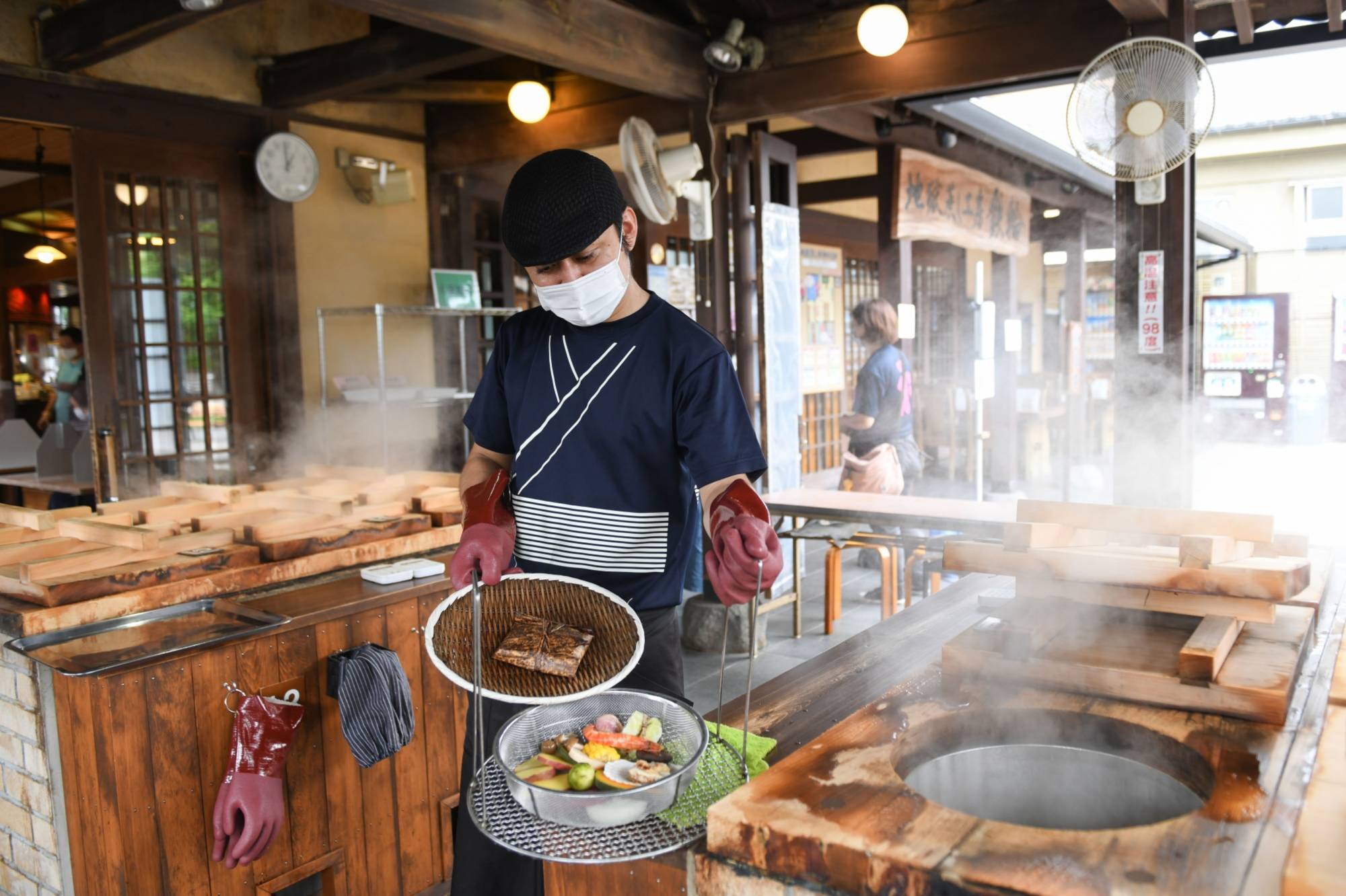
Japan will run a new domestic tourism subsidy program from Oct. 11 to late December as part of efforts to spur domestic tourism and revive the coronavirus-hit economy, tourism minister Tetsuo Saito said Monday.
The measure comes in line with a plan to resume individual, visa-free tourism and remove a daily cap on arrivals to the country, currently set at 50,000, on Oct. 11 as part of eased COVID-19 border control measures .
Airports and seaports across Japan will start preparations to resume international operations suspended due to the COVID-19 pandemic, Chief Cabinet Secretary Hirokazu Matsuno told a news conference Monday.
The National Travel Discount program, which is available to Japan residents only, comes in the wake of the Go To Travel subsidy program and expands on similar existing programs operating at the prefectural level.
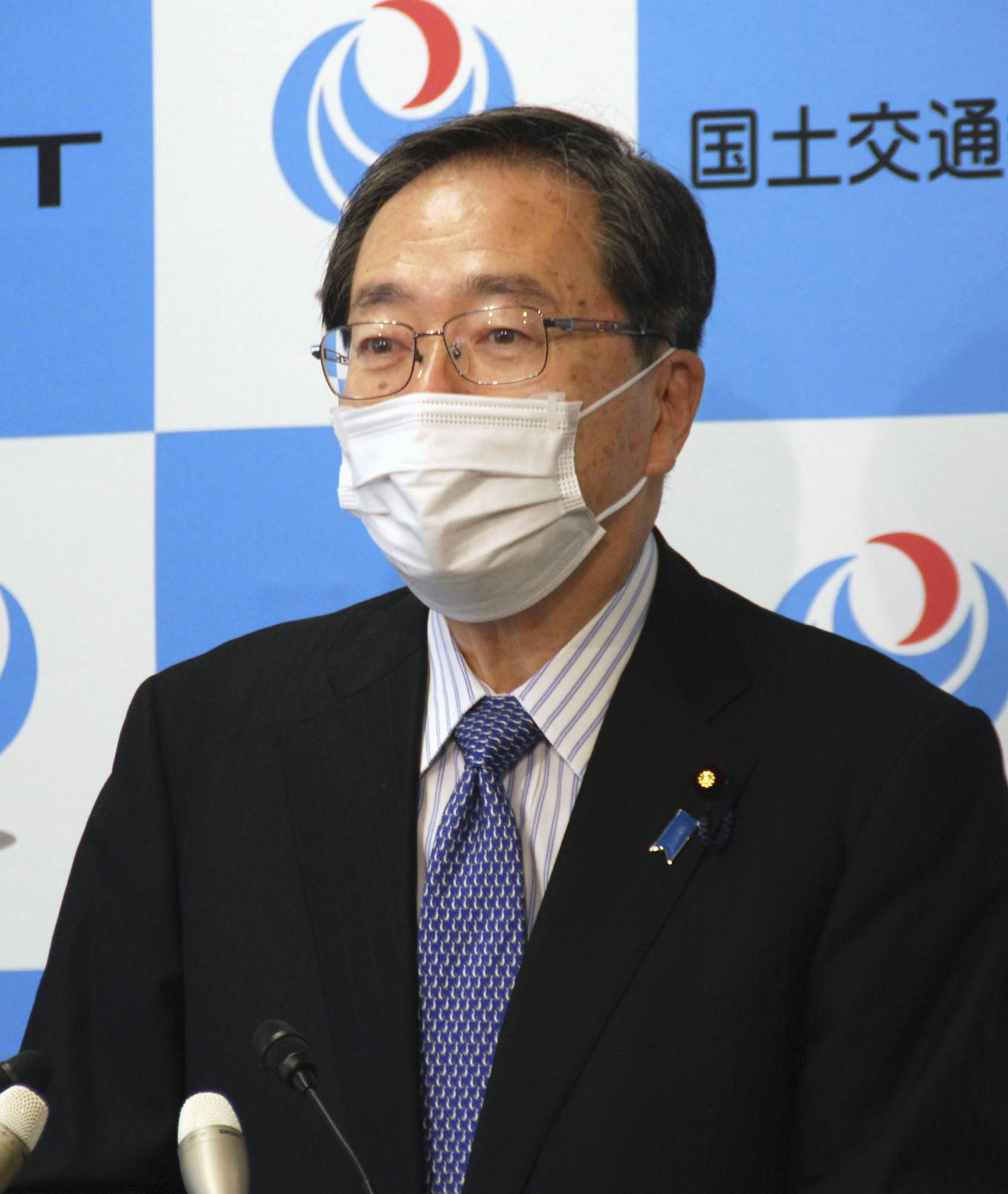
Under a system where the national government subsidizes the costs borne by prefectural authorities to implement such programs, the 47 prefectures will be allowed to suspend the program depending on the infection situation within their jurisdiction.
Prefectural governments will have the authority to determine the program's running period or whether to implement it at all, leading to the possibility that it may not be launched simultaneously across the country.
The new program was initially planned to be introduced in July but was postponed due to the nation's seventh wave of infections.
A total of 87.81 million people took advantage of the Go To Travel program from July 22, 2020, until it ended on Dec. 28, 2020, due to the spread of the virus.
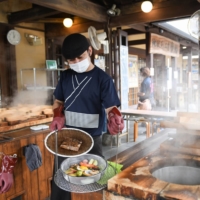
In a time of both misinformation and too much information, quality journalism is more crucial than ever. By subscribing, you can help us get the story right.

- Language School
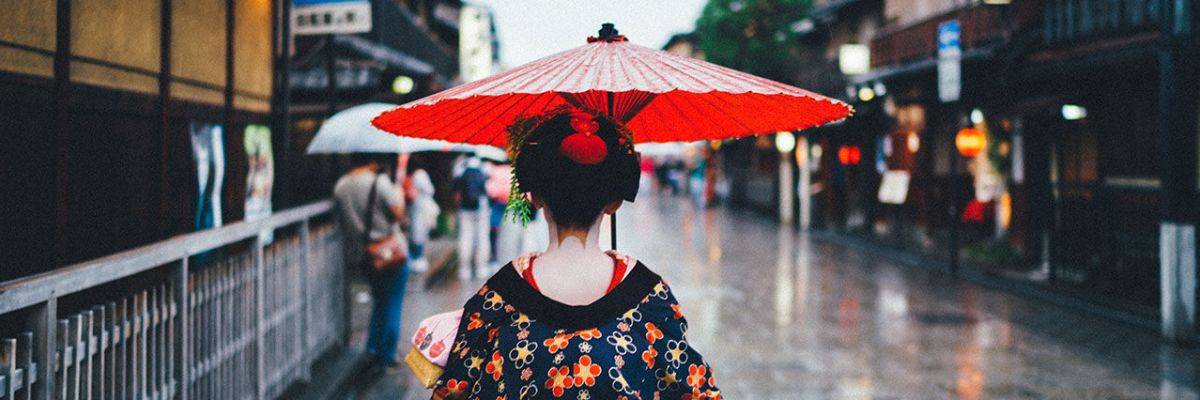
6 Best Japanese Study Abroad Summer Programs in 2024

Jessica grew up in California, where she learned to love the beach and sunny weather...and then s...
- button]:border-none [&>button]:bg-white [&>button]:hover:cursor-pointer [&>button]:hover:text-cyan-400"> button]:hover:text-cyan-400 [&>button]:bg-white hover:cursor-pointer" height="1em" width="1em" xmlns="http://www.w3.org/2000/svg">
Do you love trying new varieties of sushi? Are your weekends spent watching the latest episode of that awesome anime ? Is jamming to your fav. karaoke song totally your thing? Does your head hurt from nodding yes to all of these? Then a study abroad in Japan for college students is definitely for you—and might we recommend the most epic of options, a SUMMER program in the land of the rising sun?

Make walking through cherry blossom trees your everyday routine!
Summer in Japan
Could we love you anymore?
No, you are perfect
With Japanese study abroad summer programs, you’ll level-up in your Japanese (the ninth most spoken language in the world!), vist amazing cultural sites like shrines and temples, and learn the joys of cooling down with green bean ice cream (yes, you read that right). Summer deals at Uniqlo and pleasant mountain hikes await. Ah, yes—the joys of a summer in Japan are hard to beat, and we’re thrilled you’re taking a step towards finding your dream experience.
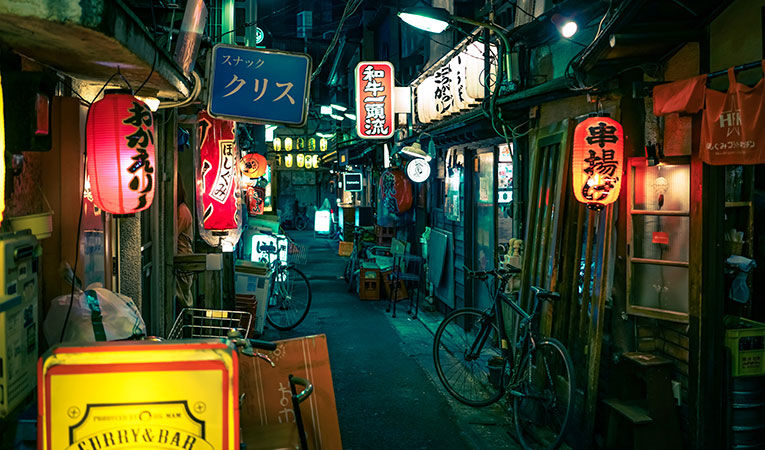
Feel safe in your new home when you choose one of these Japanese study abroad programs!
Don’t just study abroad next summer; study abroad with the best. Here are top-notch Japanese study abroad summer programs for you to send an inquiry stat!
Find a private Japanese tutor with Preply!
Say hi-ya to these 8 great japanese study abroad programs.

1. KCP International Language school
Japanese is an incredibly complex language, spoken by over 138 million people, and KCP International Language School is here to help you master it! Next summer with KCP, you’ll be taking full immersion classes for about three hours a day, five days a week. The school is located in a main hub of Tokyo, putting you in a perfect position to explore during your free time. The only downside of this program is that it includes lodging but not food. Be sure to add a little extra on to your budget when calculating the cost of this awesome program.
- Where: Tokyo, Japan
- General Cost: ~$7,000
- More program info

2. IES Abroad’s Nagoya Summer @ Nanzhan University
IES Abroad has a few Japan study abroad programs, but Nanzan University is particularly great. It’s one of the only universities that offers classes in traditional Japanese arts, like calligraphy, tea ceremony and flower arranging. You’ll be learning about Japanese culture outside the classroom, too! This program includes weekend trips culturally and historically rich places, such as Hiroshima, Miyajima, Nara and more! Because this program is all inclusive and pretty awesome, it’s a little pricey, but definitely worth it! (Plus, they’ve got tons of financial aid).
Alum Maya Best shares: “Participating in [this program] this past summer truly transformed my Japanese language ability and increased my confidence.” What could this program do for YOUR Japanese fluency?
- Where: Nagoya, Japan
- General cost: ~$20,000
- More program info

3. CISabroad in Tokyo
CISabroad is well-known for their awesome support abroad, and their Japanese study abroad summer programs are no different! From airport pickup to a comprehensive tour of Seisen University, where you’ll be studying, CISabroad is with you every step of the way. Plus, they offer awesome cultural excursions to different shrines, temples, and plenty of other cultural and historic landmarks. On these trips, you’ll experience a Japanese tea ceremony and even wear a yukata! Experience the ancient and the modern next summer while in good hands.
- General cost: ~$4,000

4. JaLS Group: Hokkaido Japanese Language School
Learn Japanese quickly and cheaply next summer with JaLS Group! For small class sizes and plenty of time to explore on your own, try this Hokkaido Japanese language school. This program offers great customization—you can stay for one week or twelve, courses are flexible, and several different housing options are provided. Their seasonal field trips are the cherry on top of your adventure in Nihongo.
- Where: Sapporo, Japan
- General cost: ~$1,000 per week
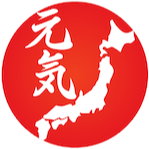
5. Genki Japanese and Culture School Study Abroad in Fukuoka
Fukuoka is famous for its amazing restaurants, so this study abroad is perfect for all you foodies out there! Plus, studying at Genki Japanese and Culture School is a super affordable way to spend next summer abroad in Japan. The longer you stay, the more discounted price you get! There’s no age limit with this program, so you’ll meet people of all ages and nationalities. Small class sizes, diverse classmates, and amazing ramen on every corner—sign us up!
- Where: Fukuoka, Japan
- General cost: ~$300 per week

6. World Campus International - Japan
For a more comprehensive experience, try studying abroad in Japan with World Campus International, which offers language programs in different regions around the archipelago. This program whisks you to a new city every week! While there are no official classes, language practice with your host family and cultural immersion experiences offer awesome (and effective) substitutions. The only thing cooler than seeing a real samurai demonstrate how to use a katana? Having the samurai hand you the katana and teach you how to use it! (And later recounting the tale to your host mom and dad in their native tongue!).
- Where: Nagasaki, Kumamoto, Osaka, Nara, Chiba, Tokyo, and more!
[ View ALL Study Abroad Programs in Japan ]
Have a blast during summer study abroad programs in japan.
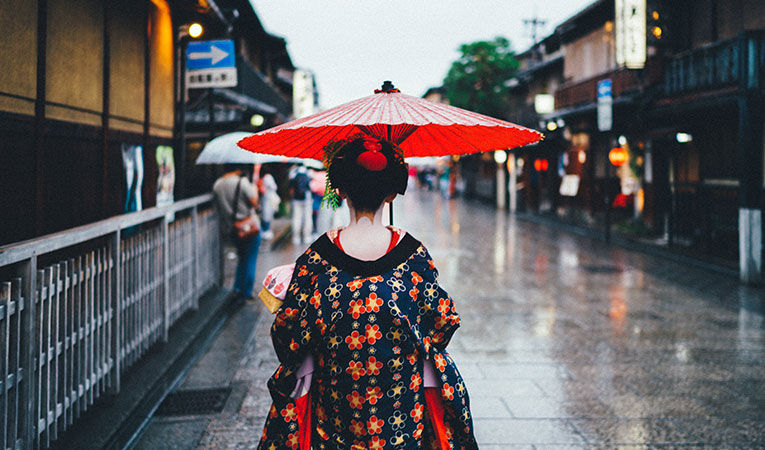
You’re ready for an awesome summer in Japan!
Studying abroad is an amazing experience. You’ll have incredible adventures galore while exploring Japanese study abroad summer programs! Though Japan study abroad programs aren’t without difficulties, we know fearless and awesome travelers like you will rise to meet the challenge!
And Japan is super awesome! Its rich culture and friendly natives will make your study abroad the best! So dust off those old mangas and whip out some creative ramen recipes to give you inspiration while you apply to one of these awesome study abroad programs in Japan!
Use MyGoAbroad to Find & Compare Study Abroad Programs in Japan for College Students with Confidence

Explore Language Immersion Programs on GoAbroad.com
Related Articles
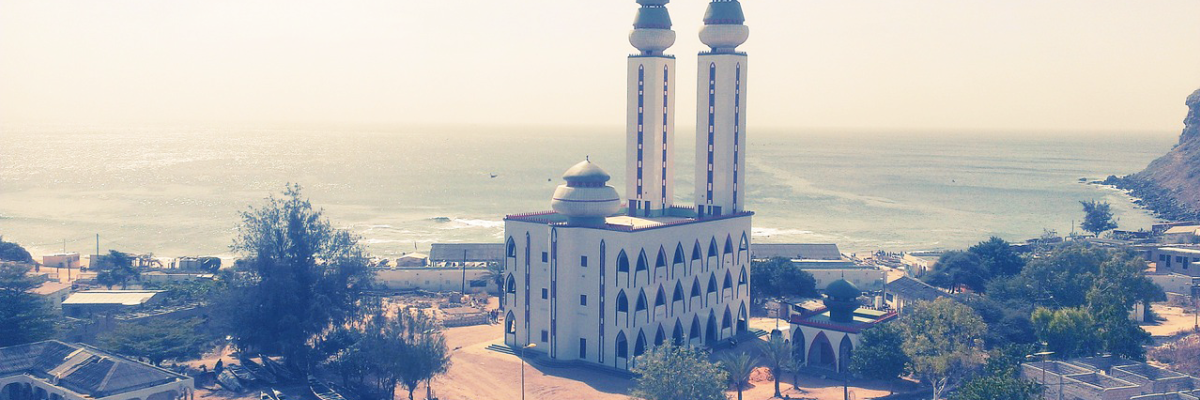
By Mary Ellen Dingley | 3 days ago

By GoAbroad 2018 Official Report | 3 days ago

By Carter Brown | 3 days ago

By GoAbroad 2018 Official Report | 4 days ago
Popular Searches
Recommended programs.

KCP International Japanese Language School

Meiji Academy

LTL Language School
Top Language Program Providers
Popular opportunities to check out
Learn Spanish with the Top-Rated Programs in Latin America
Online spanish course for all levels at an accredited school, prepare to speak confidently with the best online tutors, learn and immerse in thai language and culture, for travelers, travel resources, for partners.

© Copyright 1998 - 2024 GoAbroad.com ®
- Study Abroad
- Volunteer Abroad
- Intern Abroad
- Teach Abroad
- TEFL Courses
- Degrees Abroad
- High School Abroad
- Language Schools
- Adventure Travel
- Jobs Abroad
- Online Study Abroad
- Online Volunteer Programs
- Online Internships
- Online Language Courses
- Online Teaching Jobs
- Online Jobs
- Online TEFL Courses
- Online Degree Programs

- JET Program
- Eligibility Criteria
- Contract, Salary & Benefits
- Placement in Japan
- Orientation & Training
- Testimonials
- How to Apply
- Our Application & Departure Process
- Required Documents
- Interview & Departure Locations
- Get Involved with AJET
- Employment Verification
- JET Alumni Associations
- Opportunities for JET Alumni
- Alumni Profile
- General FAQ
- Application FAQ
- - JET Program
- - Positions
- - Eligibility Criteria
- - Contract, Salary & Benefits
- - Placement in Japan
- - Orientation & Training
- - Testimonials
- - How to Apply
- - Our Application & Departure Process
- - Required Documents
- - Interview & Departure Locations
- - Get Involved with AJET
- - Resources
- - Support
- - Employment Verification
- - JET Alumni Associations
- - Opportunities for JET Alumni
- - Alumni Profile
- - General FAQ
- - Application FAQ

The only teaching exchange program managed by the government of Japan

Represent the U.S.A. as a cultural ambassador to Japan

2025 Applications open this fall
Our applications for 2025 departures to Japan will open mid-September, 2024. Want to be a 2025 JET participant? Check out our Positions, Eligibility Criteria, and How to Apply pages for the details!

Meet and Talk with JET Office
Our offices across the US will be holding information sessions for 2025 JET applications starting spring of 2024. Join for a chance to talk to our Program Coordinators and JET Alumni!

Get Answers
If you have questions our our Program and our application process, look no further! Answers can be found here. Before submitting your application, please check our FAQ!
Welcome to the Japan Exchange and Teaching (JET) Program. Founded in 1987, JET has sent more than 77,000 participants from around the globe (including more than 35,800 Americans) to work in schools, boards of education, and government offices throughout Japan. What makes JET unique is that it is the only teaching exchange program managed by the government of Japan. With more than 75 countries around the world currently participating in JET, this program offers a unique cultural exchange opportunity to meet people from all around the world, living and working in Japan. Before departing for Japan and upon return, there are a number of JET alumni organizations that host social, volunteer and professional development activities to help individuals through the transition process. Becoming a JET puts you in an elite network of incredible individuals. Join us for the adventure of a lifetime!
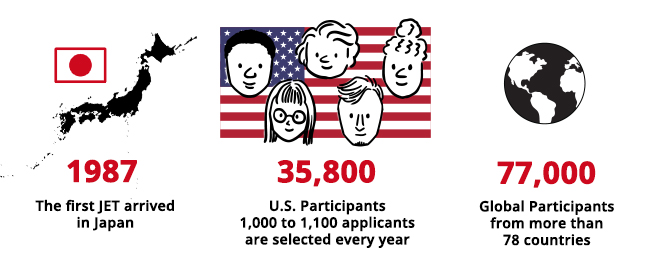
Promotion of Educational Travel to Japan
- ABOUT JAPAN EDUCATIONAL TRAVEL
- arrow_right WHY JAPAN?
- arrow_right Traditional culture
- arrow_right Modern culture
- arrow_right Natural environment
- arrow_right Japanese food
- arrow_right Sports
- arrow_right Made in Japan
- arrow_right Crisis management
- arrow_right Social systems and infrastructure
- arrow_right Peace and friendship
- arrow_right SCHOOL IN JAPAN
- arrow_right JAPANESE EDUCATIONAL SYSTEM
- arrow_right SCHOOL LIFE IN JAPAN
- arrow_right PLAN YOUR TRIP
- arrow_right SUGGESTED ITINERARIES
- arrow_right SCHOOL EXCHANGES
- arrow_right TIPS FOR A SUCCESSFUL ONLINE SCHOOL EXCHANGE
- arrow_right IN-PERSON EXCHANGES
- arrow_right ONLINE EXCHANGES
- arrow_right VISITOR'S VOICES
highlight PLAN YOUR TRIP
In order to plan your study trip to Japan, you can begin here by firstly learning basic information and fun facts of this country and its unique culture. For the planners and guests of school trip, all the important details to help coordinate an inspiring trip in Japan can be found here.
Located in East Asia, Japan is an island nation that lies on the West Pacific Ocean. With an area of 377,973.89km 2 , it is the 62nd largest country in the world. Japan has a population of 123.22 million people, the world's 11th highest, and its GDP of 4.941 trillion US dollars ranks as the 3rd largest in the world (based on Feb. 2021 data).
info Basic Information
Highlight travel tips, location_city safety.
Japan is one of the world's safest countries for travelers. Its strong law enforcement agencies, stable political environment and stable economy allow Japan to top the peaceful country index in Asia.
local_drink Health and Hygiene
The tap water is safe for drinking, and there is also easy accesses to bottled water. The food safety in Japan is of the highest standard as well.
local_hospital Medical System
The advanced medical system in Japan provides high-quality service. On an occasion of emergency, you can call 119 for an ambulance, and emergency care is available 24/7 at most general hospitals. If you need regular assistance from a doctor, visit a clinic, general hospital or other medical institution and ask for help at reception. For medication requiring no prescription, simple treatments and medical supplies, you can go to one of the many drugstores and consult the pharmacists or registered clerks if necessary. More information on medical services in multiple languages can be found at the link below. Guide for when you are feeling ill (JNTO) open_in_new
train Domestic Transportation
The public transportation network in Japan is well-developed and can take you to almost all popular destinations and attractions quickly and safely. The high-speed railways (shinkansen/bullet train) and highways cover nearly the whole of Japan, connecting major cities. The railway and highway bus services allow tourists to easily travel even long distances around the country. You will be pleased by their smooth trips, their precise schedules, quality operations and reasonable fares. In addition, these country-wide transport networks link to the local railways and metro systems in many cities. By using an IC card you can ride and transfer between railways and metro systems simply with no need to buy a ticket every time. It's simple!
wb_sunny Climate
Most of areas of Japan falls within warm and cool temperate zones of relatively high humidity climate. Japan is a perfect destination for immersing oneself in nature and enjoying the beauty of its four distinct seasons. The sight of flowering sakura (cherry blossoms) in spring is a particular favorite of tourists, as are summer festivals where you can eat shaved ice to help you cool down in the hot nights of summer. Autumn is the season of maple leaves with their fall shades of yellow and red creating spectacular scenery. And, of course, there is winter which best time for enjoying skiing on Japan's world-class snow and warm yourself with a shabu shabu hot pot. On average, the month of January is the coldest, while August is the hottest month of the year. The rainy season of Japan falls within the period June to July.
directions_run Natural Disasters
Situated on the Circum-Pacific Seismic Belt and near the subtropical zone, Japan is well-known for natural disasters, such as earthquakes and typhoons. Due to plate tectonics, Japan was geologically formed as a mountainous country with volcanic eruption and tsunami taking place sometimes. Learning the lessons of its past natural calamities, Japan has developed a highly organized and efficient system of precautions, education, relief and risk management. Despite the inevitable loss brought by these acts of nature, Japan takes advantage of its naturally occurring landscapes and experience in coping with disasters to continue to reestablish tourism and local economies afterwards, and to continue to develop state-of-the-art technologies to mitigate loss and protect people.
star Muslim travelers
Recently, the number of Muslim travelers visiting Japan has been growing year by year. The number of Muslim-friendly halal-accredited restaurants and other facilities as well as mosques in Japan have also been increasing. The tourism policies have also been adjusted in response to the needs of the expanding Japanese Muslim community as well as Muslim tourists. In general, Japan is religion-tolerant and is striving to build a Muslim-friendly environment to meet the standards of Halal tourism. Currently, Japan has no specialized agency for halal accreditation, but Muslim-friendly resources and information can be found at Japan Welcome Guide for Muslim Travelers , Japan Guide for Muslim Visitors , Halal Gourmet Japan, and Halal Expo Japan.
Let's see how to coordinate the perfect educational travel plan for your students. For planning educational travel and school exchange events during the trip, go to our School Exchange page to get ideas.
Travel Guide
Personalize your educational travel with the travel guide to the key information for getting around in Japan. Start by picking travel dates, locations and places to stay.
event When to visit
Get to know the distinct climate and seasons in Japan to plan your visit dates.
January is the coldest month of a year. The weather is often windy and dry. From January 1, New Year, through the beginning of this month, most of schools, public services and many private sector businesses are closed for New Year Holidays.
It's still cold and sometimes snowy in February. Plum blossoms can be seen in certain areas. Generally, February is the period when students take entrance exams for high school and college.
The spring is approaching, and cherry blossoms begin to bloom in most regions from mid to late March. From the end of March, students have a Spring break that lasts until the beginning of April.
It is spring and the season of flowering wisteria. Every year, schools start their new academic year at the beginning of April.
The average temperature rises to a pleasant 15-20 degrees Celsius, but sometimes it is cool so travelers should bring light coats or jackets. At the beginning of May, there is a seven- to ten-day public holiday called "Golden Week".
The early summer season of June is warm and famous for being the hydrangea flower season. It becomes more humid as the rainy season starts in June.
Entering summer, the weather heats up, and sometimes there are typhoons. Many festivals (matsuri) are held in summer.
The weather of most of the regions remains hot and humid. Occasionally, there are a few typhoons from June to September (the main typhoon season). Most of Japanese students are on summer vacation in August, and around the mid August, there is a seven- to ten-day vacation.
The season turns into autumn in September. During daytime, the weather is mostly mild and comfortable, but during the nighttime it is best to have jackets to keep warm.
As mid-autumn comes, maple leaves gradually turn orange and red hues. It's generally cool and comfortable in October and that makes this month a hot season for tourists.
It becomes colder, and some regions in Japan may start to see frost and light snow. November is the month that winter sports resorts start to open to guests.
It gradually becomes cold in December, and some areas snow is to be expected. Over the year-end and New Year period many people, government services and organizations tend to take a break of about one week.
info Destinations
Haven't decided where to visit and stay? Take a look at the guide to ten regions in Japan.

Embrace and explore the wide green fields of Hokkaido. The unpolluted environment offers the chance to get close to nature, a soothing experience for the travelers' mind. With a variety of outdoor activity options, you can stretch your limbs and try some challenging physical exercise surrounded by nature such as cycling, canoeing, hiking and rafting. In winter, Hokkaido treats the visitors with the world-class winter sports venues and resorts. Come to enjoy skiing, dog-sledding and snowboarding in the snow season! arrow_right ITINERARIES: Enjoy the abundant nature and delicious food of Hokkaido
Find more Hokkaido open_in_new
The Tohoku area includes six prefectures of the mixed culturalscape consisting of rich historical sites, rural and suburban settlements, and magnificent natural landscapes. Gradually recovering from the disastrous earthquake in 2011, the area has become a popular destination for international tourists in the recent years with its quality produce, its varying landforms and views, in August, the spectacular festival, Aomori Nebuta Matsuri, and Hiraizumi listed on UNESCO World Heritage, in Iwate. Don't forget to taste sweet cherries in Yamagata and juicy peaches in Fukushima. arrow_right ITINERARIES: Learn about the 2011 Tohoku Earthquake and Tsunami, and experience traditional customs and festivals
Find more Tohoku open_in_new
The Kanto area is where the megacity Tokyo is located. In addition to the amazing experience of night views and shuttling through the hustle and bustle of this metropolis, the UNESCO World Heritage listed city of Nikko just two to three hours away is definitely worth a visit. Around Tokyo, there are prefectures with historical treasures and hot springs, such as Gunma and Saitama. To explore the region's diverse marine, international trading and immigrant culture, visit Yokohama, the port city of Kanto famous for its fusion lifestyle and food. arrow_right ITINERARIES: Follow the renowned “Golden Route” in Japan
Find more Kanto open_in_new
Hokuriku Shinetsu
Boasting the beautiful Northwestern coastline of the main island and the mountains of the "Japan Alps", the Hokuriku Shinetsu area has nurtured the rich culture consisting of delicacies, exquisite crafts and a lifestyle balanced between the nature and human activity. Besides enjoying the best of fresh seafood, sake and fruits in the country, it is worth an artistic trip to Kanazawa, the cultural capital of the area to learn about traditional crafts and contemporary designs. In addition, Niigata and Nagano are two of the best locations in Japan for winter sports. arrow_right ITINERARIES: Deepen the exchange with Japanese people, and learn about social system and rice agriculture in Japan
Find more Hokuriku Shinetsu open_in_new
The Tokai area is renowned as the home of Mt. Fuji. Around this icon of Japan, there are resorts of hot springs and natural splendors, such as Hakone and the Fuji Five Lakes area. Feel like immersing yourself in history and culture? Visit the Historic Villages of Shirakawa-go and Gokayama listed as UNESCO World Heritage Sites, and visit Isejingu Shrine, one of the most time-honored Shinto shrines of Japan. For those tea lovers, don't miss the green tea plantations in Shizuoka. arrow_right ITINERARIES: Deepen the exchange with Japanese people, and learn about social system and rice agriculture in Japan arrow_right ITINERARIES: Follow the renowned “Golden Route” in Japan
Find more Tokai open_in_new
Kansai is the cultural and religious capital of Japan with castles that have survived the centuries, spiritual Zen gardens, and many culturally important ancient temples and shrines. Immerse yourself in the tranquility and majesty of the religious and historical sites in Kyoto, Nara and Wakayama. If you are a fan of history or architecture, don't miss the most well-preserved of all Japan's castles Himeji Castle in Hyogo Prefecture that represents the glory of samurai culture and Japanese traditional craftsmanship. Just an one to two-hour's trip by train from the sites above, Osaka and Kobe are gourmet paradises with nice ambience thanks in part to their photogenic night views. arrow_right ITINERARIES: Follow the renowned “Golden Route” in Japan
Find more Kansai open_in_new
Located in the west of the main island, the Chugoku area is the bridge to the island regions of Kyushu and Shikoku. The most famous tourist attraction in Chugoku may be the famous "floating" Itsukushima Shrine in Hiroshima Prefecture. In Hiroshima, There is an Atomic Bomb Dome the UNESCO World Heritage listed. In Tottori and Shimane, there are rural landscapes, and Shimane's Izumo Taisha Shrine is worth a visit as the sacred place that is believed to be the gathering venue of all the gods of Japanese Shinto religion. In addition to the ancient shrines, you can learn about the modern history of Japan and "Meiji Reforms," the modernization movement of the country in the 19th century, at various historical sites in Yamaguchi. The one of the regions most popular attractions with foreign visitors is the Mizuki Shigeru Museum and yokai (monster and spirit) statues of Kitaro Road in Tottori. arrow_right ITINERARIES: A peace study tour to Nagasaki and Hiroshima: Contemplating peace
Find more Chugoku open_in_new
Shikoku is the smallest among the four main islands of Japan, but is definitely the most vibrant with its abundant resources in nature and culture. Take a rail tour to enjoy the views of Seto Inland Sea coastline, and if you happen to visit Shikoku in summer, you may plan an island hopping journey to appreciate artworks of the Setouchi Triennale. Don't forget to taste the udon noodles of world-fame produced in Kagawa and visit one of the Japan's oldest hot springs, Dogo Onsen with its history of over a thousand years of use. In Kotohira, see Japan's oldest working kabuki theatre and try climbing the thousand steps of Konpira-san Shrine.
Find more Shikoku open_in_new
Kyushu, the southernmost of Japan's four main islands, has warm and comfortable weather nearly all year round. There are two historical port cities in Kyushu, Nagasaki and Mojiko, and both have fusion styles of food, architecture and communities as they were the earliest gateways to Japan, open to international trade, travel and immigrants. Visit Kumamoto and Kagoshima to view the magnificent volcanic landscapes and experience a hot sand bath. Don't miss the famous Kumamoto Castle, and be sure to add Oita, known as "the prefecture of hot springs," to your traveler's bucket list! arrow_right ITINERARIES: A peace study tour to Nagasaki and Hiroshima: Contemplating peace
Find more Kyushu open_in_new
As the southernmost part of Japan's long island chain, Okinawa is a prefecture of subtropical climate and a resort for beaches and water sports. Come to explore the historical sites and restored Shuri Castle of the former Ryukyu Kingdom. Dive into the sea to visit the marine world of colorful coral reefs and undersea aquatic life. Whale-watching and dragon boat races are the exclusive and fun events that you can join in to enjoy the coastline and sea world of Okinawa. Do you know that karate originated in Okinawa? Come to learn more about it!
Find more Okinawa open_in_new
hotel Accommodation
From hotels to homestays, different styles of accommodation are open to the students on educational travel. See the introductions to the recommended accommodation options.
Hotel / Inn
The inns run by the large hotel chains are the easiest and most common choices for the tourists traveling to Japan. Most of the inns have sufficient and large rooms and space to accommodate groups and for group activities. The clean environment, great locations, easy access to booking and stable quality of service are the main reasons for these inns to become international travelers' favorites.
Japanese Hotel "Ryokan"
Feel like experiencing Japanese culture during your stay at a hotel? Japanese hotels, called "ryokan" in Japanese, offer not only great experience in accommodation, but their service and culture are steeped in Japanese-style and traditional conventions as well. At a Japanese hotel, you may stay in an antique Japanese house and enjoy authentic Japanese cuisine. Some traditional Japanese hotels even have their own hot spring and offer Japanese bathrobes to their guests.
Homestays may be a best way to get closer to and learn from Japanese lifestyle. Instead of staying at hotels, you may interact and make friends with the locals while learning first hand about everyday Japanese life by spending a few nights with a Japanese family. It's also a valuable opportunity to exchange and stimulate conversations between cultures.
Farmstays allows people to stay with host families in farming and fishing villages and have an experience distinctly different from staying at hotels in urban areas. Staying in the countryside or seaside town, you have the access to the abundant surrounding nature, and a chance for an unforgettable experience meeting the local communities involved in forestry, fishing and farming. In some cases you may even get a little taste of their worklives by trying your hand at harvesting food, tending livestock, or other chores.
chrome_reader_mode Educational Programs
The educational travel can be theme specific, focused on culture, history, nature, food, sports or any other theme you would like.
Helpful Links
See here to access to more tourist resources and information about transportation all over Japan.
JAPAN TRAVEL GUIDE open_in_new
The official tourism website of Japan by Japan National Tourism Organization.
Japan Tourism Agency open_in_new
The official website of the Japan Tourism Agency.

Related Information

The Ministry of Foreign Affairs website uses JavaScript. Please turn on "JavaScript" and use it.

The Working Holiday Programmes in Japan
The working holiday programmes are, based on bilateral arrangements, intended to make it possible for the youth of Japan and its partner countries/regions to enter each country/region primarily for the purpose of spending holidays while allowing them to engage in employment as an incidental activity of their holidays for the purpose of supplementing their travel funds.
The programmes are designed to provide the youth with wider opportunities for them to appreciate the culture and general way of life in the partner countries/regions for the purpose of promoting mutual understanding between Japan and its partner countries/regions.
Japan started the working holiday programmes first with Australia in 1980. As of 1st August 2023, Japan has introduced the programmes with the following 29 countries/regions.
[Note] Provisionally initiated in December 1999.
2. Eligibility to participate in the working holiday programmes
To participate in the working holiday programmes, an applicant must satisfy the following requirements.[Note]
[Note]The requirements may differ depending on the nationality of the applicant. Further information on visa application procedures can be obtained from Embassies or Consulates-General of Japan in your country/region or Interchange Association (Taipei Office or Kaohsiung Office) .
- For a national of Australia, New Zealand, Canada, the Republic of Korea, the United Kingdom, Ireland, Denmark, Norway, Portugal, Poland, Slovakia, Hungary, Spain, Argentina, Chile, Iceland, Czech, Lithuania, Sweden, Estonia, Netherlands, Uruguay, Finland or Latvia, an applicant must be currently residing in his or her country of nationality; for a resident in Hong Kong, an applicant must possess a valid HKSAR or British National Overseas passport; for a resident in Taiwan, an applicant must possess a valid passport of Taiwan.
- Intending primarily to spend holiday in Japan for a specific length of time.
- Being between 18 and 30 years of age both inclusive at the time of application for the visa; As for Australia, Canada, Republic of Korea and Ireland, an applicant should be between 18 and 25 years of age except in those cases where the competent authorities of Japan agree to extend the limitation of age to 30 years. In the case of Iceland, the applicant should be between 18 and 26 years of age.
- Not being accompanied by dependents or children.
- Possessing a valid passport of his or her country/region and a return travel ticket or sufficient funds with which to purchase such a ticket.
- Possessing reasonable funds for the maintenance of his/her stay during the initial period of stay in Japan.
- Being in good health.
- Never having been issued a Japanese working holiday visa in the past.
3. Procedure of the working holiday visa application
The application for the visa must be made to Embassies or Consulates-General of Japan in your country/region or Interchange Association (Taipei Office or Kaohsiung Office) .
4. Work Conditions
Participants in the working holiday programmes are allowed to engage in employment as an incidental activity of their holidays for the purpose of supplementing their travel funds.
The working holiday participants are strictly prohibited from working at bars, cabarets, nightclubs, gambling establishments and other premises affecting public morals in Japan. If a participant works at such a place, he or she is deemed to violate Immigration Control and Refugee Recognition Act and will face deportation except where he or she is deemed to be victims of human trafficking.
It is also to be noted that those who are engaged in having the working holiday participants work at these establishments could face criminal charges for promoting illegal work or the buying or selling of persons.
5. Procedure at a municipal office
6. other information.
Please beware of fraudulent entities that may offer help in obtaining working holiday visas as there is no organization, including incorporated associations, in Japan with which the Ministry of Foreign Affairs cooperates in operating the working holiday programmes.
Sometimes we request consenting working holiday participants to answer a questionnaire afterwards. We would appreciate it if you could kindly cooperate with us.
Trip within a Trip: Osaka and Kyoto, Japan

May 1, 2024 • 9 min read
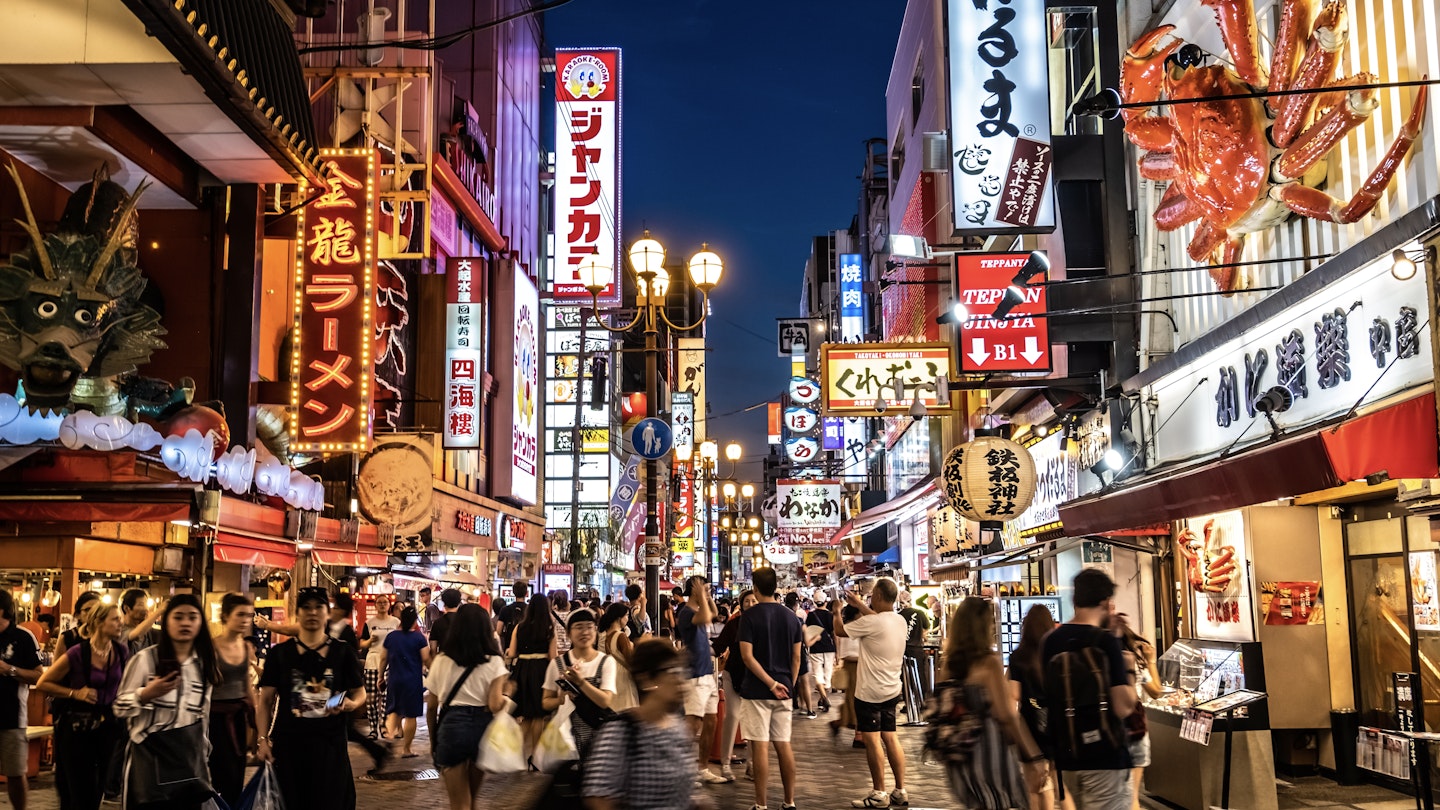
Make your next trip to Japan even better by adding on four days in exciting Osaka (pictured) and Kyoto © EarnestTse / Shutterstock
Senior Director of Content Laura Motta recently spent 10 days in Japan . To make the most of her time in the country, she included a four-day mini-excursion to Osaka and Kyoto – a trip within a trip, if you will, which anyone can replicate.
Everyone goes to Tokyo , and I would never tell you to skip it. But another critical part of any Japan itinerary is that magical Shinkansen (bullet train) ride south to Osaka , and the astounding sites that await beyond. A mind-boggling pair of cities – Osaka and Kyoto – are crammed with more shrines and temples, steel-and-glass skyscraper malls, scenic vistas and world-class restaurants than you can experience in a month, never mind in just a few days. This was my third trip to Japan and my second time visiting Osaka and Kyoto.
Before I get to my recommendations, here are a few practical tips:
- When to arrive: Arriving in Osaka around midday lets you drop your bags at the hotel, rest and then hit Dōtonbori in the evening, when its famous neon lights are ablaze.
- Getting there from the airport: The spotless, inexpensive airport limousine bus from Kansai Airport makes eight stops in Osaka, which include all of its main train stations.
- Getting around: Japan is world-famous for the ease and comprehensiveness of its public transit for a reason. You can – and certainly should – do this route without a car. High-speed (more expensive/faster) and local (less expensive/slower) trains cover every inch of this region and will shuttle you quickly between Kyoto and Osaka. Both cities have easy-to-use subway systems.
- What to pack: Certainly, your walking shoes and room in your stomach for a lot of ramen. Keep in mind that Japan has four distinct seasons and temperatures vary significantly between them. Check the weather ahead of time – and pack accordingly.
- How to structure your days: It’s tempting to cram your schedule when there are so many things to see. Yet realistically, you won’t be able to do more than two major sites – maybe three, if you’re really going for it – in a single day. This is especially true in Kyoto, where the best sites are far apart and can require up to an hour of travel to reach.
- Take it easy: Don’t forget to eat, hydrate, rest and wander. And tell yourself you’ll be back.
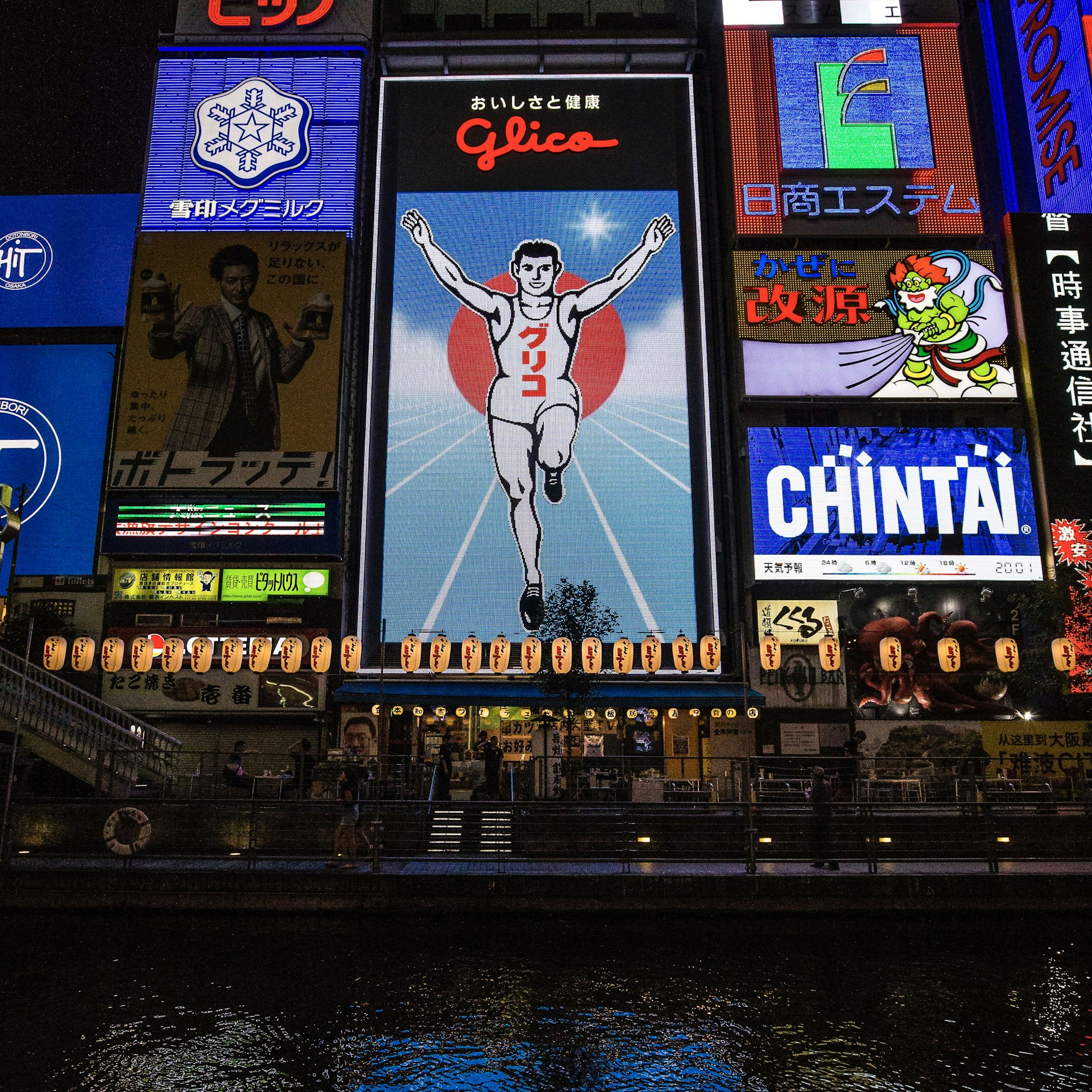
Day 1: Osaka
Snack time .
You’ve been traveling all morning. It’s time to eat. (Unless, of course, you stuffed yourself en route on the amazing bento boxes you can get at Tokyo Station.) Keep it simple like I did and grab onigiri (rice balls) or a sando at 7-Eleven. There’s one on every corner, you’ll only spend a few dollars, and buying local snacks – especially in Japan – is among travel’s greatest joys.
See the neon
If you’re in Osaka, go see the Glico man. It's a rule. Or maybe it's just mine. This famous animated sign of a runner, arms raised, about to cross the finish line in some hypothetical marathon in the sky, remains delightful despite the tourist crush on the streets below. This ad for the Glico candy company (candy bars give you energy – get it?) has become an informal mascot of Dotonbori , Osaka’s dining and nightlife district. After dark, it’s fun to wander here through the area’s many arcades, claw-machine and pachinko parlors, and shops. If you start here on a weeknight, it’s delightfully quiet.
Insider tip: Arrive before sunset and duck into a tiny side street to Hōzen-ji , a small temple known for its moss-covered statues. I was there when they were lighting the lanterns for the evening – a dreamy experience indeed.
Have a cheap and cheerful dinner
Dotonbori is teeming with restaurants. You can’t miss the distinctive signage advertising takoyaki (grilled octopus balls), gyoza and crab. My favorite takoyaki stand, Takoyaki Yoriyabunzaemon , is humble compared to its bombastic neighbors; there is no 5ft marquee. Inside, you’ll sit on a well-worn barstool while the single cook pours takoyaki batter into the famous round molds and serves it to you still piping hot, and slathered in mayo, barbecue sauce and bonito flakes. A warning: if you value the skin on the roof of your mouth, do not eat too fast here.
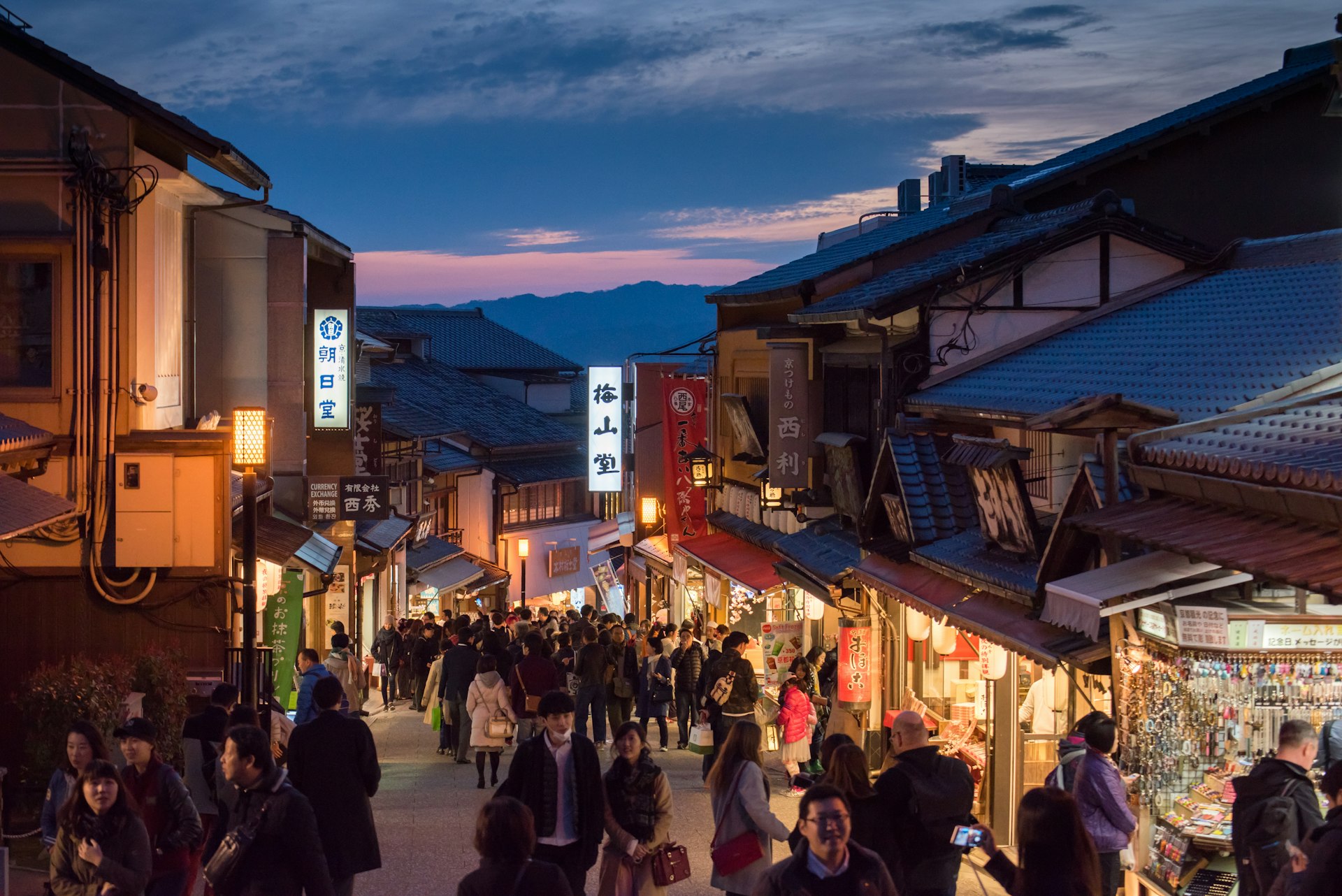
Day 2: Kyoto
Bullet train .
The Shinkansen train between Osaka and Kyoto is cheap and lightning fast. This trip is included in many Japanese rail passes , but if you’re paying for a standalone ticket, you’ll pay 1420 yen (about US$10). The trip takes 15 minutes, so slower local trains hardly seem worth the mildly cheaper price. Arrive midday and head to your hotel to check in and drop your luggage. Before you depart, don’t forget to look around Kyoto Station for the eki ink stamp, which you can imprint into a notebook as a souvenir. Every train station in Japan has a uniquely designed stamp, even if you sometimes have to ask the attendant at smaller stations where to find it.
Stay in style
If there’s one place to splurge on a fabulous hotel in Japan, it’s in Kyoto. Whether you’re strolling under vibrant fall leaves or spring cherry blossoms, or wandering the narrow alleys and stepped streets of the Gion district , Kyoto is romantic, its temples and shrines otherworldly. My choice was Hotel the Mitsui Kyoto , a new luxury property that blends smart contemporary design with traditional Japanese accents. Beside its excellent restaurant – more on that below – the highlight is the hotel's updated approach to the traditional onsen . This vast, moodily lit indoor space offers heated pools and loungers amid beautiful rock formations and water features. And unlike many onsen experiences, this one is a bathing-suits-required, mixed-gender space where everyone can hang out. There is also no surcharge for entry.

Visit the temples
My boyfriend cheekily refers to Fushimi Inari Taisha , Kyoto’s famous shrine with its rows and rows of vermillion gates ascending a dramatic hillside, as “the Instagram shrine.” It’s hard to say that he’s wrong: the site is a favorite among foreign travelers for good reason. The gates are simply gorgeous and – yes – photogenic. Just don’t expect to find yourself there alone.
Insider tip: Afterward, stop at the charming Vermillion Cafe for a sweet snack and coffee. Sit on the back porch, which overlooks a lovely stretch of forest, for especially serene vibes (spectacular in autumn).
If you still have energy left in the afternoon, head to Nishi Hongan-ji , a mammoth Buddhist temple complex that’s home to some of the largest wooden structures in Japan. After you marvel at the huge lanterns and expansive halls, stop by the brightly painted Chinese Gate, which dates back to the late 1500s. This temple is also within walking distance of Kyoto Station, and can be a good place to start or end your trip.
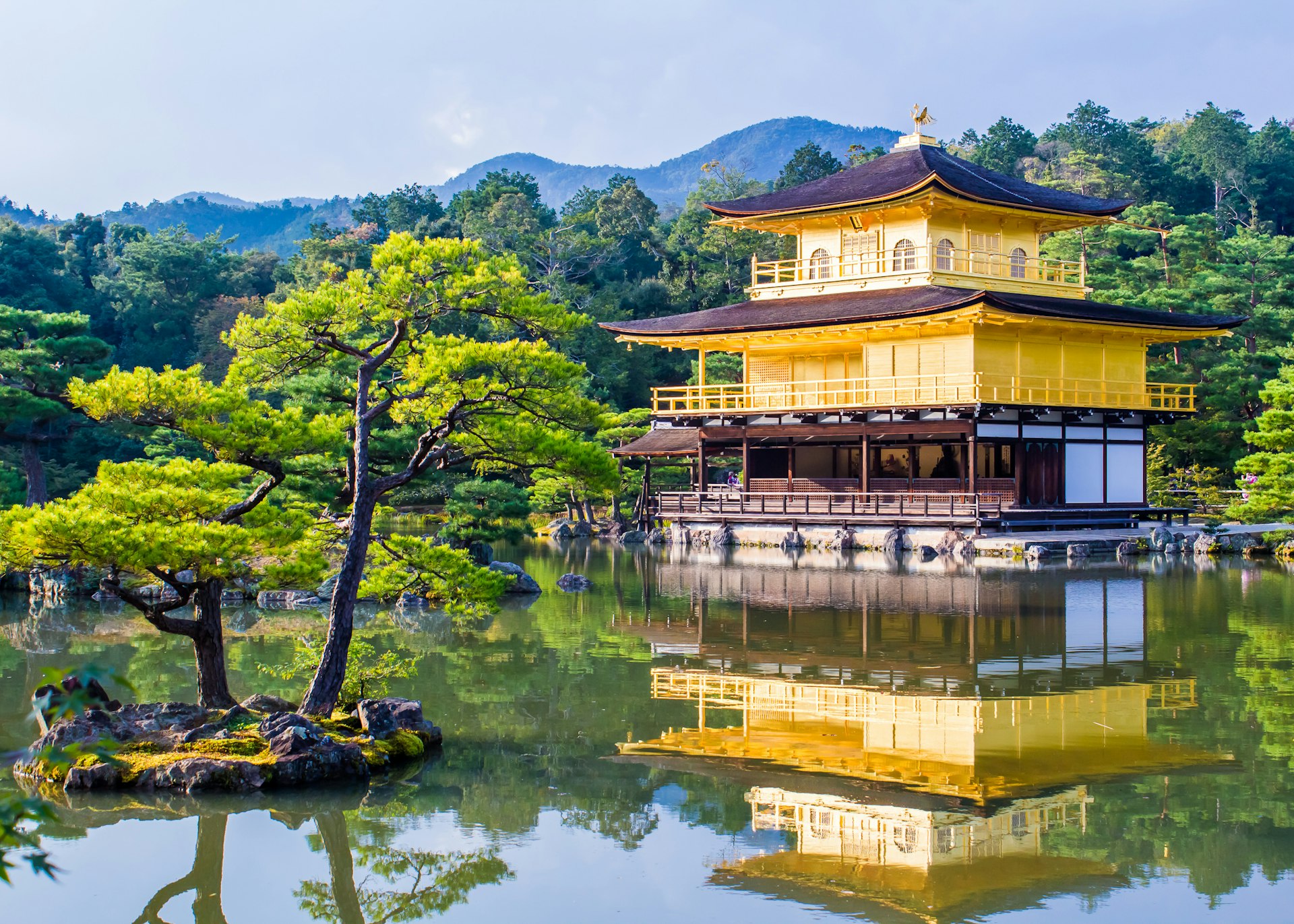
Day 3: Kyoto
Go for the gold.
Kinkaku-Ji , sometimes called the Golden Pavilion, is among Kyoto’s (and Japan’s) most famous and photographed landmarks. This UNESCO World Heritage site , where a brilliant gold temple appears to float along the shores of a serene lake, is well worth braving the crowds for, especially in sunny weather when the reflection of the lake glints off of the temple’s exterior walls. Go early, packing your patience – and you’ll understand instantly why so many people flock here.

School Bus Coffee Stop is a charming spot for an easy, affordable breakfast or lunch in cozy, industrial-farmhouse-style surroundings. Comforting selections like bagel sandwiches and avocado toast are accompanied by the shop’s excellent, house-roasted coffee.
Modern love
For an aesthetic palate cleanser after a quick lunch, stop by the Kyoto City KYOCERA Museum of Art , which houses rotating exhibits, often of contemporary and modern art, in a fantastic brick structure that dates to the 1930s.
Taste sensation
And you’d be remiss if you stayed at the Mitsui without eating at its elegantly flamboyant Italian restaurant, Forni . Yes, there are pizzas and pastas on its à la carte menu. But I’d highly recommend the tasting dinner, where impeccably composed dishes like sea bream citrus tartare and grilled wagyu arrive on geometric plates and stands. It’s a feast for the eyes as well as the stomach.
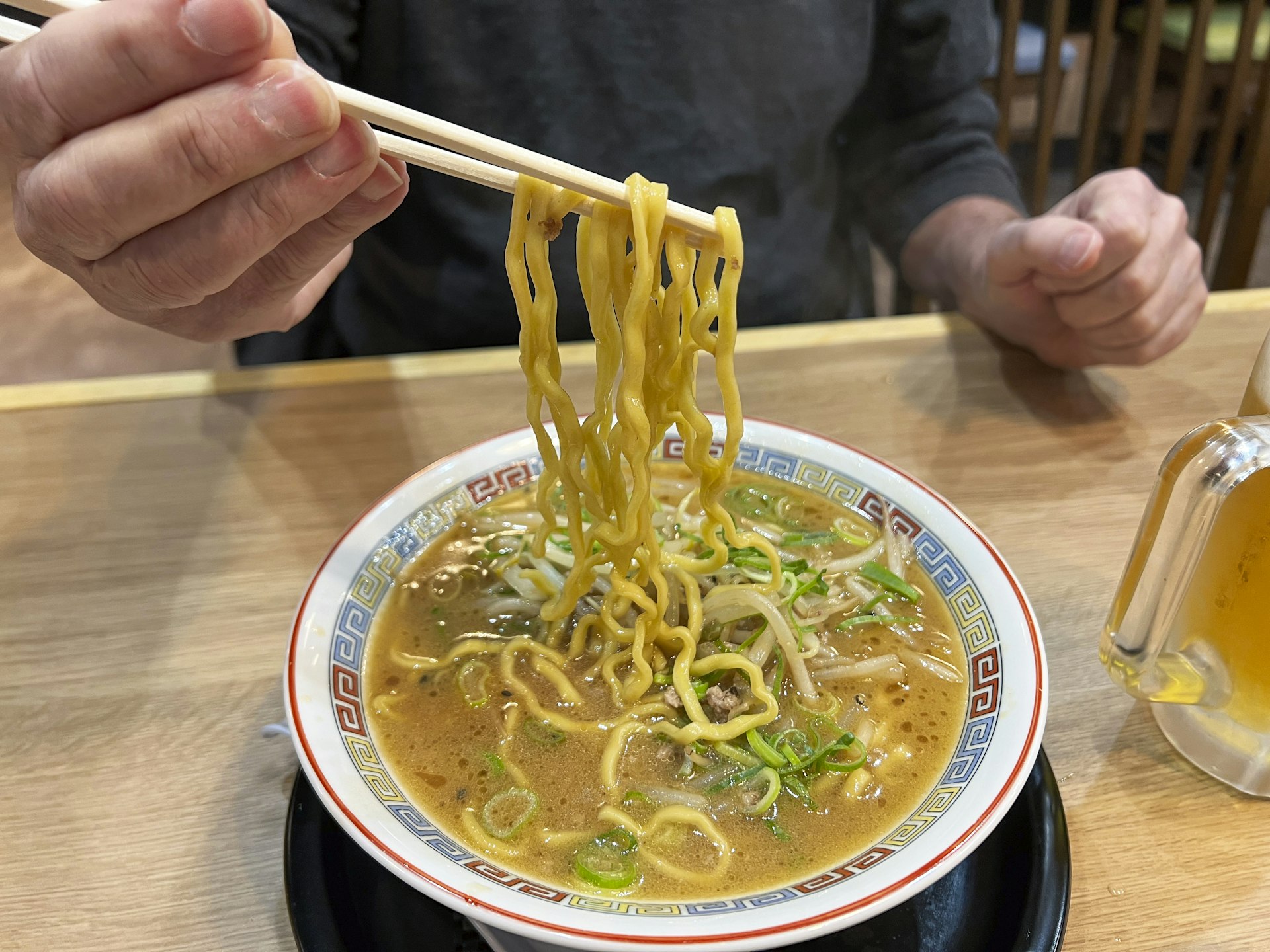
Day 4: Osaka
Smart hotel.
After going luxe in Kyoto on meals and lodging, I came back to Osaka looking to save money without sacrificing too much comfort. I wasn’t ready to sleep in a sarcophagus-sized pod or get every meal at 7-Eleven. (Well, not every meal – just a few.) After getting off the train from Kyoto at the massive Shin-Osaka Station, I took the easy-to-use metro to one of the best places I’ve stayed in Japan, the chicly designed, austere-but-comfortable Hotel Noum , just across the river from Temmabashi Station. The location made transportation connections easy and kept me sheltered from the stark urban rush of Umeda, Osaka’s high-rise business district. Rooms are small, comfortable and spotless; mine had a river view. The hotel also has an airy coffee shop in its lobby that attracts as many locals as travelers. I popped in here for a breakfast pastry and a latte and was ready to start the day.
Window(less) shopping
Even if you don’t stay in Umeda, visiting the neighborhood is a must. Spend a day wandering its cavernous, endless indoor shopping malls and underground food courts. You may never see daylight, but you will find everything from Hermès bags to the best 300-yen (US$2) gyoza you’ve ever tasted. I like to check in on the enormous red whale, which hangs suspended from the atrium of the Hep Five department store, which also happens to have a ferris wheel on its roof.

Enjoy a messy lunch
Train stations are where you’ll find some of the best food in Japan – and Osaka’s sprawling Umeda Station is no exception. My favorite train-station ramen is at Menya Takei, located behind the entry gates for the Hankyu Railway. Menya Takei specializes in tsukemen , in which the ramen noodles and broth are served separately. Dip the noodles into the broth to eat – yes, you’ll undoubtedly get it all over your clothes, but that’s part of the fun. Lots of laundry to do when you return home is a sure sign of a great trip.
Insider tip : Ask the gate agent to let you through. They’ll make you pay for a rail ticket on the way in, and then may refund you on the way out.
From Osaka, hop back onboard the Shinkansen for more exploring in Japan, or do what I did and catch a quick, affordable domestic flight to Tokyo’s Haneda airport to connect to your flight home.
Keep planning your trip to Japan:
The 24 best things to do in Japan Find out if you need a visa to enter the country Take to the open road on these top drives How to discover Japan on a budget
Explore related stories

Public Transport
Jan 31, 2020 • 7 min read
Whether you want canals, ceramics or buzzing cities, there’s a stop for you on the ‘sunny side of the mountain’. Here’s how to explore San'yō by train.

Apr 3, 2024 • 17 min read

Apr 2, 2024 • 10 min read

Mar 31, 2024 • 7 min read

Mar 28, 2024 • 7 min read

Mar 28, 2024 • 6 min read

Mar 28, 2024 • 11 min read

Mar 26, 2024 • 8 min read


Japan Discovery and Service
Program overview.
Join Travel For Teens on this journey to Japan, the Land of The Rising Sun. Japan is a country full of ancient cultures, strong traditions, and the technology of the future. Perform meaningful community service in Tohno – an area devastated by the 2011 Tsunami. You will enjoy a cultural exchange with teens from a local high school, spend a day in the rice fields and get to know the people who call Tohno home.
In addition to our service work you will visit the evocative sites of Hiroshima, try your hand at the ancient art of karate, taste the best sushi of your life and experience the scramble at the world-famous Shibuya crossing. From the flashy cityscape of Tokyo to the peaceful temples of Kyoto and the majesty of Mt. Fuji, Japan will astonish even the most well-traveled students.
$7595 + $600 Rail Pass + Airfare
- Jun 25 - Jul 11 Limited
- Jun 29 - Jul 15 Very limited
- Jul 11 - Jul 27 Full
- Jul 27 - Aug 12 Very limited
Finishing Grades
9, 10, 11, 12
Who Can Go On This Trip?
Students from around the world!
Where We Go
Tokyo, Enoshima, Tono, Nikko, Nagoya, Hiroshima, Kyoto, Miyajima
Optional Group Flight There
Los Angeles (LAX) to Tokyo (NRT)
Optional Group Flight Back
Tokyo (NRT) to Los Angeles (LAX)
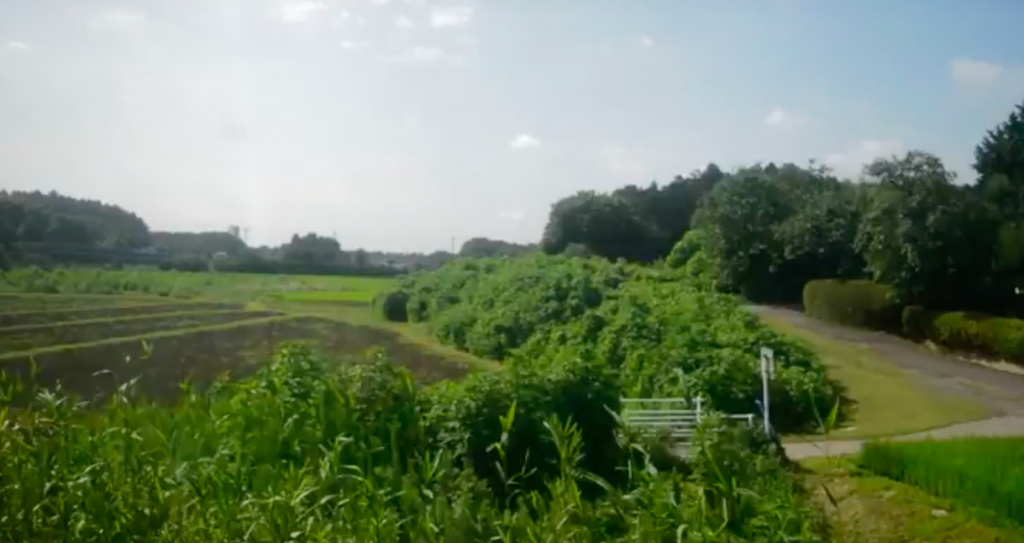
During this program, you will…
- Earn up to 10 hours of service credit volunteering with a local community on a variety of projects, including a cultural exchange at a Japanese high school
- Visit the Ghibli Museum, Miyazaki’s world famous anime museum**
- Eat the best sushi of your life at the Tsukiji Fish Market
- Try your hand at making your own sushi in a cooking class
- Become the next karate kid with a lesson in traditional Japanese martial arts
- Participate in a traditional tea ceremony
- Take video gaming to the next level at the largest Virtual Reality facility in Japan
- See the famous Toshu-gu shrine; a UNESCO World Heritage site and home of the “See No Evil–Hear No Evil–Speak No Evil” monkeys
- Experience the visceral realities of war and learn about the dangers of nuclear proliferation at the Hiroshima Peace Museum
- Try to spot a Geisha or Maiko in the traditional city of Kyoto
**Important Note: Admission to The Ghibli Museum is not guaranteed until a month prior to departure.
Trip Itinerary
Day 1: depart from los angeles (lax), days 2 – 4: tokyo.
Our adventure begins amidst the bustling streets and sparkling lights of Tokyo. Visit Miyazaki’s animation studio where classics like Princess Mononoke, Laputa, and Totoro were created. Hit up the famous Akihabara area, home to video games, anime, and manga, and shop in the colorful Harajuku District. Head to the top of the government building for incredible views of the city and stare in awe at Shibuya Crossing, the busiest street crossing in the world! Wander through the world famous Japanese fish market and visit several stunning shrines. And no trip to Tokyo would be complete without tasting everything this bustling city has to offer, including ramen, sushi, and teppanyaki!
DAYS 5 – 10: TONO > NIKKO
After exploring fast paced Tokyo, it’s time to slow it down a bit by journeying up north to Tono. The charming town of Tono is home to Japanese mythology and folklore, including the mysterious Kappa water fairies! After hearing some traditional Japanese tales (and maybe even going on a kappa hunt!) we will participate in a variety of sustainability projects, as well as a special cultural exchange with a local high school. We will spend time shadowing the students and discovering what a typical day is like in a Japanese high school. You will have the chance to join them in a variety of their classes, including English class where you may be helping them with presentations or other projects! In return, you will learn how to do calligraphy and take part in a tea ceremony. You can expect to form valuable friendships with these students and learn more about the Japanese language and culture.
To cap off our time in Tono, we will visit the area devastated by the 2011 tsunami. It is an opportunity to reflect on the past, discover what current efforts are being made to get the area back to normal, and look towards the future. Students will leave Tono feeling like they had a true cultural experience, as well as the opportunity to see first-hand the impact a natural disaster can have on a community and learn ways to assist in relief efforts.
Then it’s off to visit the sacred site of Nikko to visit the Toshu-gu Shrine. After marveling at Nikko’s iconic red bridge, we will enjoy a relaxing hike through the tranquil countryside to discover the natural beauty of Northern Japan, including Kegon falls.
DAY 11: NAGOYA
Hop on the high-speed bullet train to our next destination! En-route to Hiroshima we will stop in Nagoya to learn more about a well known traditional Japanese art…karate!
We will visit a local dojo where you will learn from certified instructors and even be assisted by some of their regular students! This is a great opportunity to get hands on with this well-loved Japanese art and interact with the locals. You will learn a variety of moves, including kicks, strikes, stances, and even how to chop a piece of wood!
Our karate class is meant to be fun and a way to further explore Japanese culture. No skills are necessary to participate. Students who are currently practicing karate at home are encouraged to show off their moves!
DAYS 12 – 16: HIROSHIMA > KYOTO
Our last two stops bring us to Hiroshima and Kyoto. Hiroshima today is dedicated to bringing peace to the world, a direct result of the destruction the atomic bomb brought to it during WWII. During our time here we will have the special opportunity to meet with a local survivor and hear his or her perspective on this tragic event. Every year our students are moved by hearing such a personal and emotional story, and come away with a greater understanding of the effects of WWII. In past years, our groups have even had the unique opportunity to be interviewed and featured on the local news for our global perspective!
In Hiroshima we will also visit the stunning island of Miyajima. This island is home to the symbolic “floating” Torri gate that appears to be gracefully standing in the water during high tide. On Miyajima we will enjoy wandering through a local food market and also explore some of the natural beauty the island has to offer. Miyajima also happens to be home to a plethora of friendly deer. Don’t be surprised if one (or several!) comes up to you looking for you to pet them. Don’t worry, they don’t bite!
After Hiroshima it’s on to Japan’s cultural gem: Kyoto. This charming city is famous for its beautiful temples and shrines and we will have several days to explore its stunning golden temple, tranquil rock gardens, and ornate palaces. On the way to Kyoto, stop at the gorgeous 700 year old Himeji Castle!
Our time in Kyoto will also be very interactive. After learning about geishas, we will go for an evening geisha walk to spot them strolling about the historical city center. We will experience a traditional Japanese tea ceremony and learn exactly what is involved with this ancient art. We will also enjoy a fun and exciting taiko lesson, where we will learn to play these traditional Japanese drums with instructors in a fun and easy to learn format. To cap off our lesson we might even have a drum battle! To enjoy nature, we will hike through a bamboo forest, as well as visit the famous orange torii gates at Fushimi Inari Taisha shrine.
Kyoto will also include plenty of opportunities to shop and play arcade games. Students who are brave enough will also be able to showcase their singing skills at a local karaoke hotspot!
DAY 17: TOKYO > RETURN FLIGHT TO THE USA
After leaving Kyoto we will have time for one last day in Tokyo to see whatever we may have missed the first time around before heading home. Whether it is shopping, exploring more temples, more arcade time, or getting in a few more bites of our favorite Japanese delicacies, our last day will be the perfect way to cap off an unforgettable journey.
Ready For Your Next Adventure?
Space is limited, reserve your spot! Then get ready for an authentic teen travel experience this summer!
Save A Spot
Request An Itinerary
Photo Gallery
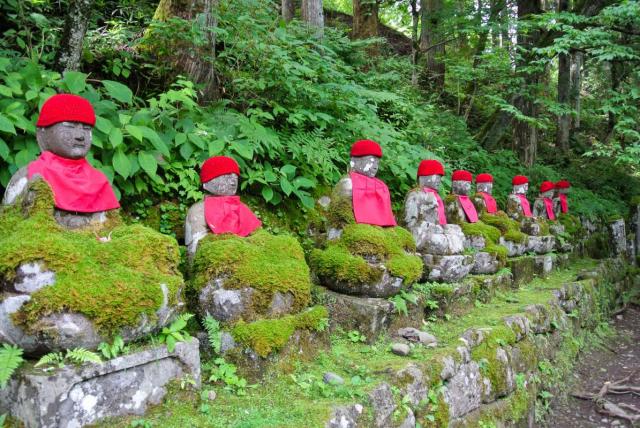
Check out other TFT programs similar to this one!

South Korea Discovery & Service
- Jul 15 - Jul 31 Available
Current Grades
Program length.
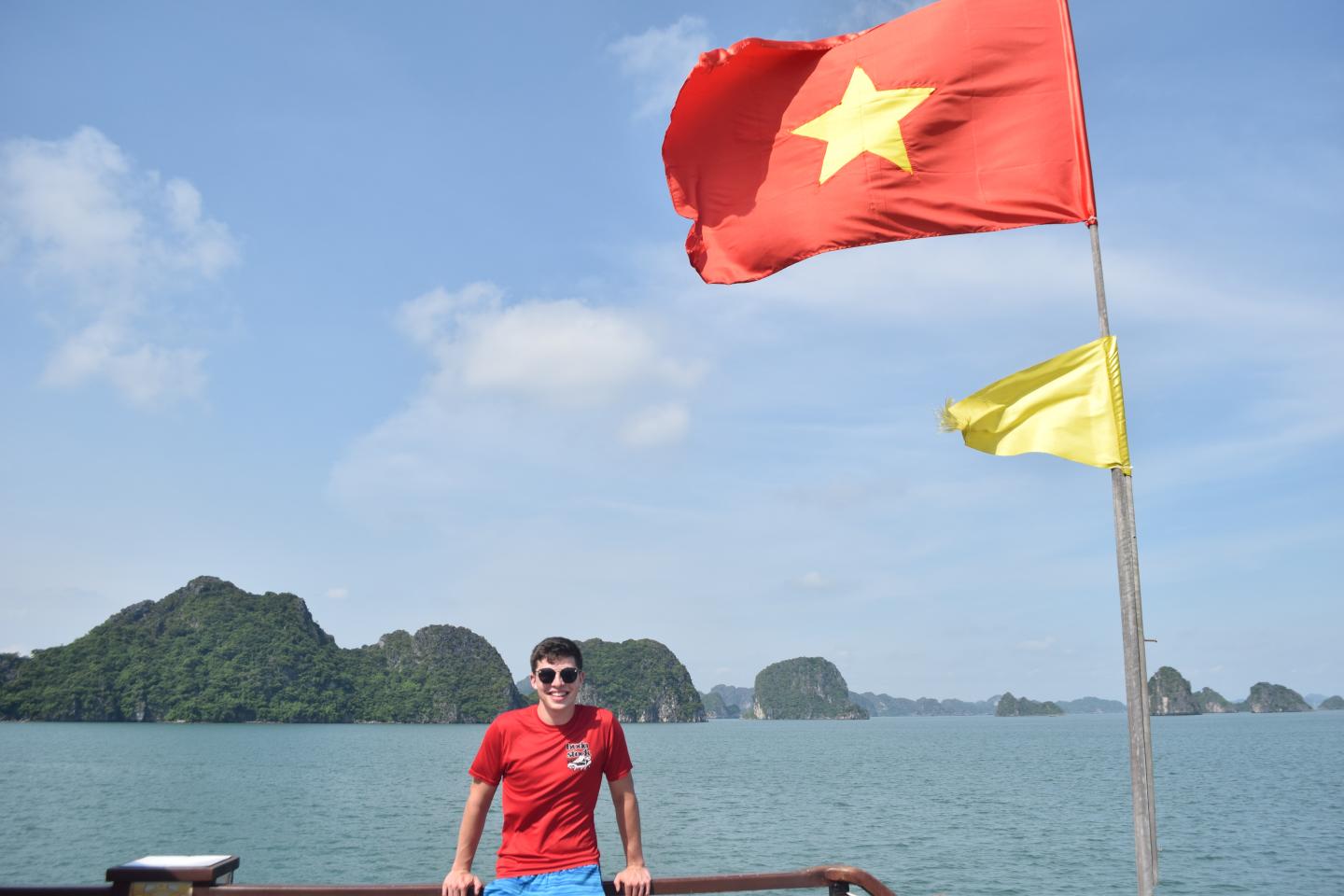
Vietnam Service & Adventure
- Jul 11 - Jul 20 Limited

Thailand Elephant Service & Explorers
- Jun 25 - Jul 4 Full
- Jul 27 - Aug 5 Available

Thailand Elephant Service & the Islands
- Jun 25 - Jul 11 Full
- Jul 27 - Aug 12 Available
Authenticity is engrained in everything we do. Eat, stay, and travel like a local.
Check out what past travelers have to say about TFT and discover why we are consistently awarded “Top Youth Travel Organization” year after year.
See all program reviews
"I really enjoyed reading your daily reports detailing all of the amazing and wonderful activities that this group did, and I shared each update with our family and friends. We were all so thrilled (and slightly envious!) to read about each day's adventures and to see all the great photos of these kids... what a happy and fun-looking bunch! I am sure they have all learned so much from this experience.. I know that for Ariel it has been transformative, and a dream come true." Tonya Cortlandt Manor, NY
"I've been traveling with TFT since I was 13, and it has been one of the best learning and growth experiences in my life. Through TFT, I've met great friends from all around the world, experienced amazing places, and was pushed out of my comfort zone and grew so much. It even helped me pick my career. In the summer of my 11th year of high school, I went on the Japan Discovery & Service trip. I had recently picked up an interest in digital photography and it just so happened that the trip director for my trip was a professional travel photographer. After traveling with him for only 2 weeks and seeing my photographic growth, I started taking courses in photography at my school and have ended up going to college for Fine Art Photography. Without the experiences TFT allowed me to have, I never would have found one of my biggest passions. The people I've met on the trips are good friends of mine to this day, and the experiences I had with them on the trips I've been on were unforgettable. Karaoke in South Korea with a crew of wacky friends, doing a two hour hike up one of the steepest mountains I've ever seen to take one picture, and other once in a life time experiences like that have made the TFT experience so special to me." Alex I. Signal Mountain, TN
"I just want to thank you for taking such good care of my loving granddaughter, Maddy. She has been on many exotic and fabulous trips in her short lifetime but I have never seen her so happy." Ellen F. Weston, FL
Travel with us and discover why we are consistently winning awards for Top Youth Travel Organization.

Frequently Asked Questions
See All FAQs
What is unique about the Japan Discovery & Service trip?
Japan Discovery & Service offers unique insider access to both the old and new of marvelous Japan through an itinerary planned to maximize the cultural experience and executed by TFT’s experienced and energetic team. The volunteer experience and its surrounding setting are truly once in a lifetime.
What kind of teen typically participates in this program? What are the requirements to join?
Teens from all over the world join this program! Typically, our participants are culturally curious individuals who are excited to make new friends, experience something unique, and interested in stepping out of their comfort zones and expanding their horizons.
This program is exclusively for students who are currently in grades 9th through 12th and approximately 14 to 18 years old. Students living outside of the USA are welcome to join!
What do students like most about the Japan Discovery & Service trip?
Japan Discovery & Service students love this program because they get to explore Japanese culture in so many ways! Japanese food, anime, karate, and other cultural forms are very popular in other parts of the world, our students love exploring them in their home country and comparing them their experiences with them at home. Students are also often deeply impacted by the community service portion of this program which both gives back to the community and is a tremendous learning experience.
Where do we stay?
Our hotels are chosen specifically in safe areas and are well suited to facilitating group supervision. We stay in centrally located accommodations, usually within walking distance of the main attractions. We do not use large, impersonal chain hotels on the outskirts of cities; we prefer to select smaller, family-run hotels where we establish personal relationships with the owners.
In Tokyo we stay at a centrally located hotel, close to the metro and major sights, perfect for exploring the city. In Nikko we stay at a peaceful inn on the riverside conveniently placed for exploring the UNESCO world heritage sights of the area. Our accommodation in Tono is a lovely hotel right in town. In Hiroshima we stay at a traditional Ryokan, walking distance to the world-famous landmarks. Our accommodation in the heart of historical Kyoto is a well situated three-star hotel.
For safety reasons, we do not publish the names of the accommodations we use. We do not feel it is safe to publish the name of a hotel where a group of teenagers is staying abroad. After registering, participants and parents are given access to our secure parent website where you will be able to see the names of all of the accommodations for the program.
Do most travelers go on their own?
Yes! In fact, over 75% of students who travel with us choose to come independently. This encourages teens to step further outside their comfort zone and make new friends. We believe that one of the most rewarding and exciting elements of travel is the new friendships that form along the way. When we travel by ourselves, we are bound to make new friends from all over the country and even the world. The best part is, you can travel again with your new friends on another TFT program the next summer!
If you are thinking about joining a TFT program by yourself but you are feeling unsure, please let us know! We have plenty of references from solo travelers who had great experiences and would be happy to chat with you about it.
Can I bring a friend?
Absolutely! We ask that if you do come with a friend, you and your friend(s) maintain openness to meeting new people and sharing this special experience with the entire group.
What is included?
Tuition cost includes ground transportation; accommodation; chaperones and guides; program-related activities and admissions; taxes and tips; all breakfasts and dinners.
Not included (this is not intended to be an exhaustive list) : airfare; visas and visa application fees; personal and medical expenses; activities and admissions that are not program-related or referenced in the itinerary; lunches, beverages other than filtered water at meals; participant expenses that are outside of the program description, such as excess baggage fees and damage to hotels; expenses related to unforeseen circumstances, such as transportation strikes and natural disasters.
How do the optional group flights work?
Upon registration, you will be contacted by our International Logistics Team to discuss the program’s flight details. There is no requirement to take the group flight, but there are several advantages to doing so. The group flight is usually chaperoned by a TFT staff member, and it also offers an opportunity for the students to get to know one another prior to the start of the program. Parents are responsible for coordinating transport to the departure airport – however, the logistics team will send out instructions detailing the exact meeting spot and airport point person. For additional information about flights, visit our dedicated flight page.
Who leads the program?
Our staff is a cut above the rest! We seek out two main characteristics in our counselors – extensive knowledge of and experience in our destinations, and a passion for working with teens. Our staff’s backgrounds include living abroad and working in summer camps or other educational settings. Team members are proven leaders and role models, who connect easily with others and form genuine friendships with each student – all while bringing each destination to life.
We celebrate diversity! Our staff represents 49 different nationalities, speak a combined total of 21 languages, and visited 142 countries. Additionally, 80% of our staff lived or worked abroad in their lives. With so many unique experiences to share, you are sure to gain a global perspective.
Our average minimum ratios are one staff member to every seven participants. Each program has one Trip Director with several support staff, depending on the group size. Directors must be at least 25 years old within the calendar year and have prior experience working with TFT.
What are the safety qualifications for our staff?
Our staff members undergo a rigorous hiring process. They receive the same background check as school educators, an extensive training process to go over all safety precautions and protocols, and are required to be certified in CPR and First Aid. We exclusively hire responsible, multi-talented individuals who are safety-minded and are as passionate about teen travel as we are.
What is the average group size?
We pride ourselves on small group sizes to create a more authentic and personalized experience. Our group sizes fall between 13 and 24 students – the perfect size to facilitate new friendships without feeling lost in a crowd! We believe smaller groups eliminate the likelihood of cliques, and allows for a well-rounded, healthy group dynamic.
How does this program connect to other programs?
Our program dates are designed specifically so that participants can opt to combine trips throughout the summer. When connecting to another program, your counselor will escort you to the airport on the last day of the program and assist you in meeting your next group at your new destination.
What is the food like on this program?
In a word – delicious! At TFT, we believe food is an integral aspect of the travel experience, and we make an effort to eat at authentic establishments whenever possible. There is no better way to immerse ourselves in the culture of a place then through sampling the local delicacies. We stray away from westernized restaurants and chains that cater to tourists, because every true traveler knows the best food is found where the locals are eating!
Japanese cuisine is light and flavorful; it is meant to be eaten with the eyes as well as the mouth. Like many countries, Japan has a national cuisine and also has local specialties in each province. A basic in the Japanese diet is rice, they eat it with almost every meal and it tastes great. While many foreigners think of sushi first (and we will definitely eat some of the best sushi on earth!), it is just one of many awesome Japanese foods. Seafood is an important staple of the Japanese diet, but dishes containing pork, beef, and chicken are also common. Japanese also like to eat a lot of vegetables, they serve them steamed, grilled, or fried (Tempura). Ramen and other dishes involving soba, udon, or other noodles are also there for the tasting. Most dishes are easy to eat with chopsticks if you want to give it a try!
We also love to have bento (Japanese lunch boxes) while we are out on the town from time to time, they are delicious and a great way to taste some local food while sitting out in the fresh air taking in the sights and sounds of our surroundings.
Of course, we are always willing and able to accommodate vegetarians, vegans, gluten allergies, and other dietary restrictions.
Do we ever get time to go off on our own?
Our staff and teens are nearly always together, but we do provide the opportunity to break up into smaller groups to allow for flexibility and customization within the itinerary.
We offer free time in defined safe areas – for example, shopping in a market or exploring a museum. During these times, students remain in groups of at least two and are given no more than an hour. Of course, the counselors remain nearby and available. Additionally, a lifeguard-certified counselor supervises the campers any time they are involved in water activities.
Do I need to bring anything special for the community service portion of the program?
Due to the nature of our service work in the local village, all you’ll need are clothes that you don’t mind getting dirty.
A more detailed packing list will be provided upon registration.
Do I need any vaccinations for this program?
We recommend checking with your family doctor regarding vaccinations and medical advice for the destination you are visiting. For more information, please check the World Health Organization’s website . Upon registration, we provide a list of recommended vaccinations that can be discussed further with your doctor. For Specific questions pertaining to the COVID-19 vaccine, click here .
Do I need to speak the language?
No, our skilled staff members will help you get around and even teach you a few fun phrases!
Book this Program
- Media & Industry
- Meetings & Events
- Select Language 简体中文 繁體中文(香港) 繁體中文(臺灣) India (English) Bahasa Indonesia 한국어 ภาษาไทย Tiếng Việt Singapore (English) Philippines (English) Malaysia (English) Australia/New Zealand (English) Français Deutsch Italiano Español United Kingdom (English) Nordic countries(English) Canada (English) Canada (Français) United States (English) Mexico (español) Português العربية Japan(日本語) Global (English)
- India (English)
- Bahasa Indonesia
- Singapore (English)
- Philippines (English)
- Malaysia (English)
- Australia/New Zealand (English)
- United Kingdom (English)
- Nordic countries(English)
- Canada (English)
- Canada (Français)
- United States (English)
- Mexico (español)
- Global (English)
- Fujiyoshida
- Shimonoseki
- Ishigaki Island
- Miyako Island
- Kerama Island
- Tokyo Island
- Koka & Shigaraki
- Hida Takayama
- Ginza, Nihonbashi
- Beppu & Yufuin (Onsen)
- Ginzan Onsen
- Nagasaki Islands

- Kumano Kodo
- Shikoku Karst
- Amami Oshima
- Hachimantai
- Omihachiman
- Aizuwakamatsu

- Diving in Japan
- Skiing in Japan
- Seasonal Flowers in Japan
- Sustainable Outdoors
- Off the Beaten Track in Japan
- Scenic Spots
- World Heritage
- Home Stays & Farm Stays

- Japanese Gardens
- Japanese Crafts
- Temple Stays
- Heritage Stays
- Festivals and Events
- Theater in Japan
- Japanese Tea Ceremony
- Cultural Experiences in Japan
- Culture in Japan

- Local Cuisine Eastern Japan
- Local Cuisine Western Japan
- Local Street Food
- Japan's Local Ekiben
- Japanese Whisky
- Vegetarian and Vegan Guide
- Sushi in Japan Guide
- Japanese Sake Breweries

- Art Museums
- Architecture
- Performing Arts
- Art Festivals
- Japanese Anime and Comics
- Japanese Ceramics
- Local Crafts

- Scenic Night Views
- Natural Wonders
- Theme Parks
- Samurai & Ninja
- Iconic Architecture

- Wellness Travel in Japan
- Japanese Ryokan Guide
- A Guide to Stargazing in Japan
- Relaxation in Japan
- Forest Bathing (Shinrin-yoku)

- Experiences in Japan
- Enjoy my Japan
- National Parks
- Japan's Local Treasures
- Japan Heritage
- Snow Like No Other
- Wonder Around Japan

- Visa Information
- Getting to Japan
- Airport Access
- COVID-19: Practical Information for Traveling to Japan
- Anime Tourism
- Countryside Stays
- Accessible Tourism
- Hokkaido Great Outdoors
- Scenic World Heritage in Tohoku
- Shikoku’s Nature and Traditions
- Southern Kyushu by Rail

- Traveling by Rail
- How to Travel by Train and Bus
- JR Rail Passes
- Scenic Railways
- Renting a Car
- Sustainable Travel in Japan
- Travel Brochures
- Useful Apps
- Online Reservation Sites
- Eco-friendly Accommodation
- Luxury Accommodations
- Traveling With a Disability
- Hands-free Travel
- How to Book a Certified Tour Guide
- Volunteer Guides
- Tourist Information Center

- Japanese Manners
- Spring in Japan
- Summer in Japan
- Autumn in Japan
- Winter in Japan
- Cherry Blossom Forecast
- Autumn Leaves Forecast

- Japan Visitor Hotline
- Travel Insurance in Japan
- Japan Safe Travel Information
- Accessibility in Japan
- Vegetarian Guide
- Muslim Travelers
- Safety Tips

- JAPAN Monthly Web Magazine
- Arts & Cultures
- Nature & Outdoor
- Festivals & Events
- Insider Blog
- Things to do
- Local Guides
- Food & drink
- Traditional
- Hokuriku Shinetsu

My Favorites
${v.desc | trunc(25)}
Planning a Trip to Japan?
Share your travel photos with us by hashtagging your images with #visitjapanjp

Termination of "Japan Official Travel App"
Thank you for using "Japan Official Travel App". Our App services are no longer available via the App. Please refer to the following website links below for tourism information regarding Japan.
Useful information

Tourism Information

In case of trouble

Communication Tips

- Japan Official Travel App
Please Choose Your Language
Browse the JNTO site in one of multiple languages

COMMENTS
Private Guides; Custom Itineraries; Unique Experiences. Japan's Best Customized For You. Hand-Picked Hotels & Ryokan, Hidden Gems, 24/7 In-Country Support & Unbeatable Value.
Our Japan Tours Include All Transportation, Transfers, Accommodation, Japan & More. 14-Day Tour Of Japan With Flights! Tokyo, Osaka, Kyoto, Fukuyama, Koyasan & More
Joanna Lumley's Japan. In this series, beloved British actress Joanna Lumley (Absolutely Fabulous) starts her journey in the sub-zero temperatures of Hokkaido before making her way to Honshu ...
Launched quietly in 2016, the Japan Trusted Traveler program allows foreign travelers to use the automated entry gates that Japanese citizens and residents have always (well, at least since said gates were introduced) been able to use. It sets out a number of categories that, if a foreign travelers falls into one or more, can qualify him or her ...
U.S. citizens needing urgent assistance should contact us by using our inquiry form or phone (03-3224-5000). If you need after-hours assistance in an emergency, please call 03-3224-5000 and ask to speak with the Embassy's duty officer. Emergency Contact Information for U.S. citizens.
The official site of Japan National Tourism Organization is your ultimate Japan guide with tourist information for Tokyo, Kyoto, Osaka, Hiroshima, Hokkaido and other top Japan holiday destinations. We offer travel information to make your Japan travel more comfortable and enjoyable.
On this episode of Journeys in Japan, Tom explores the historic town of Tomonoura and discovers the town's centuries-old tradition of forging steel. He also meets the local people who have ...
Days 15 & 16: Hiroshima. Day 17: Train to Hokkaido. The train to Hokkaido, Japan's northernmost island home to volcanoes and rugged landscapes, takes 15-16 hours by train. There are sleeper cars available, but you'll have to pay a surcharge (around 9,500 JPY) for a bed.
Smooth your way with a little forward planning. It is easy to feel a little overwhelmed and disoriented when you visit Japan for the first time, so find out the basics before you fly and get acquainted with the country through our helping you plan guide. Learn a little more about Japan's customs, culture and Wi-Fi connectivity, as well as its ...
Official Japan National Tourism Organization, providing free advice and information to Travelers
This movie introduces the new essential steps ahead of an unforgettable travel in Japan. General Information. Japan: the Official Guide. Japan National Tourism Organization. General tourism information of Japan in multi languages. Climate, Healthcare, Money, Visa, Emergency info, etc. ... The Japan Exchange and Teaching Programme (JET) ...
Whether you're interested in Japanese cherry blossom tours, festival tours, autumn leaves tours or special interest tours, our Japan tour packages will bring your vacation dreams to reality. Choose tours based on style, interest, date, or season. Our Japan group tour packages are fully escorted, and we can also arrange special-interest ...
Initially suspended during the year-end and New Year holiday season, Japan's domestic travel discount program was reinstated on Tuesday in hopes of giving a boost to the hospitality industry ...
Home to 1.5 million people and nestled in the mountains, Kyoto is one of the most beautiful cities in Japan. It's filled with traditional-style buildings, bamboo forests, countless Zen gardens, and ancient Buddhist and Shinto temples.It's best to divide the city into half, as attractions are sort of clumped together and getting across town takes a long time.
The Domestic Travel Subsidy Program, aiming to stimulate Japan's tourism industry, launched in October 2022. Eligible travelers will be entitled to discounts up to a maximum of 11,000 yen each. Due to the sudden flood of reservations, there is concern among those unable to make their bookings. However, a national budget of 560 billion yen has ...
Sep 26, 2022. Japan will run a new domestic tourism subsidy program from Oct. 11 to late December as part of efforts to spur domestic tourism and revive the coronavirus-hit economy, tourism ...
2. IES Abroad's Nagoya Summer @ Nanzhan University. IES Abroad has a few Japan study abroad programs, but Nanzan University is particularly great. It's one of the only universities that offers classes in traditional Japanese arts, like calligraphy, tea ceremony and flower arranging.
Welcome to the Japan Exchange and Teaching (JET) Program. Founded in 1987, JET has sent more than 77,000 participants from around the globe (including more than 35,800 Americans) to work in schools, boards of education, and government offices throughout Japan. What makes JET unique is that it is the only teaching exchange program managed by the ...
Navigate. Located in East Asia, Japan is an island nation that lies on the West Pacific Ocean. With an area of 377,973.89km 2, it is the 62nd largest country in the world. Japan has a population of 123.22 million people, the world's 11th highest, and its GDP of 4.941 trillion US dollars ranks as the 3rd largest in the world (based on Feb. 2021 ...
April 1, 2024. Japanese. Tweet. 1. Outline. The working holiday programmes are, based on bilateral arrangements, intended to make it possible for the youth of Japan and its partner countries/regions to enter each country/region primarily for the purpose of spending holidays while allowing them to engage in employment as an incidental activity ...
Last updated: Wednesday, May 31st, 2023. Get ready for your dream trip to Japan! Japan is now open to travelers from all countries or regions! Those who enter Japan on or after April 29th 2023 are not be required to present a valid vaccination certificate or a Covid-19 negative test certificate.
July 3 — July 23. July 10 — July 30. June 26 — July 16. tuition. $8,590 + airfare. View All Details. Experience the blend of culture, modernity, and more than 2,000 years of tradition that make up the fabric of life in contemporary Japan. Explore the pulsing, neon-soaked neighborhoods of Tokyo and key historical sites in Kyoto, then head ...
Stay in style. If there's one place to splurge on a fabulous hotel in Japan, it's in Kyoto. Whether you're strolling under vibrant fall leaves or spring cherry blossoms, or wandering the narrow alleys and stepped streets of the Gion district, Kyoto is romantic, its temples and shrines otherworldly.My choice was Hotel the Mitsui Kyoto, a new luxury property that blends smart contemporary ...
Program Overview. Join Travel For Teens on this journey to Japan, the Land of The Rising Sun. Japan is a country full of ancient cultures, strong traditions, and the technology of the future. Perform meaningful community service in Tohno - an area devastated by the 2011 Tsunami. You will enjoy a cultural exchange with teens from a local high ...
Any foreign visitor entering Japan must have a valid passport for the duration of their stay, and all visitors must comply with the conditions of their visas. See below for information about the current visa requirements for Japan. Visa Information. If you have any further questions, please contact the Japanese embassy or consulate in your ...
Browse our selection of tours that take you through classic travel routes, cities, towns, historical World Heritage sites, pilgrimages, and off-the-beaten-path destinations. These itineraries can be used as a foundation to craft a journey that suits you, from the remote reaches of Hokkaido, the central Fuji-Hakone-Izu National Park on Japan's ...
Japan Official Travel App" is the official smartphone app provided by JNTO, delivering up-to-date information about traveling in Japan for a safe and comfortable journey.